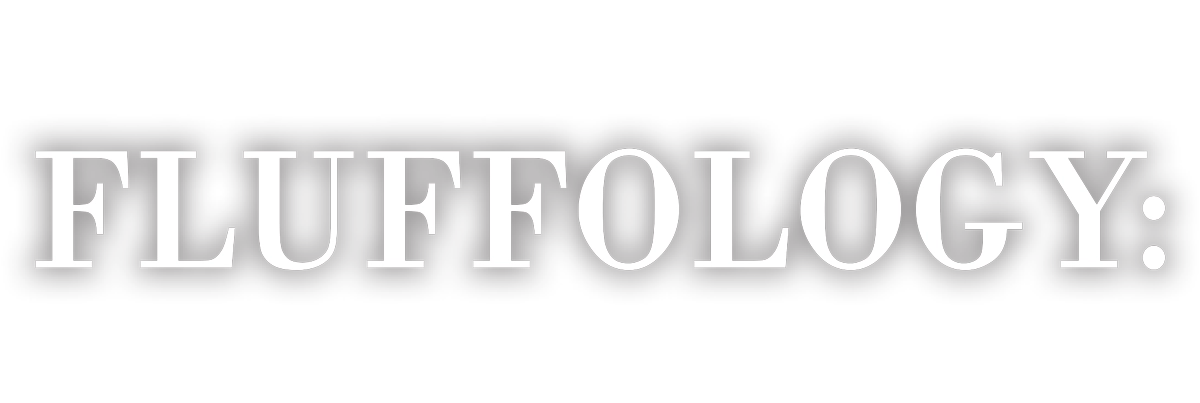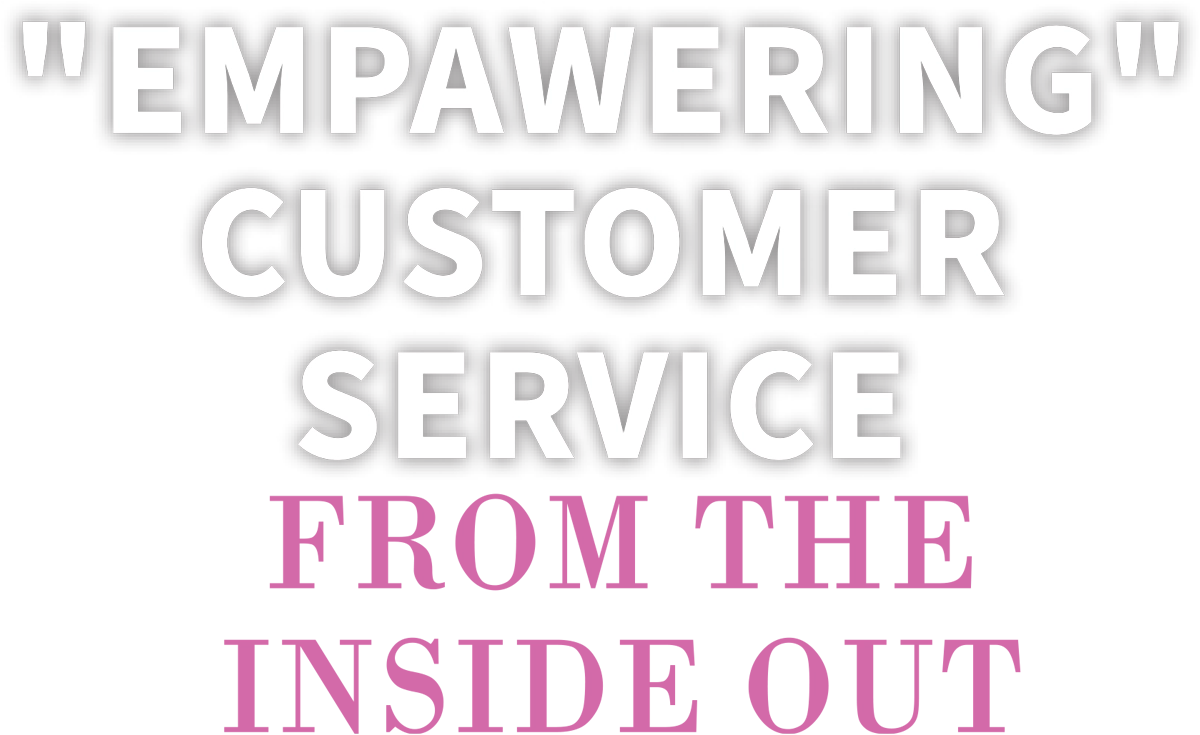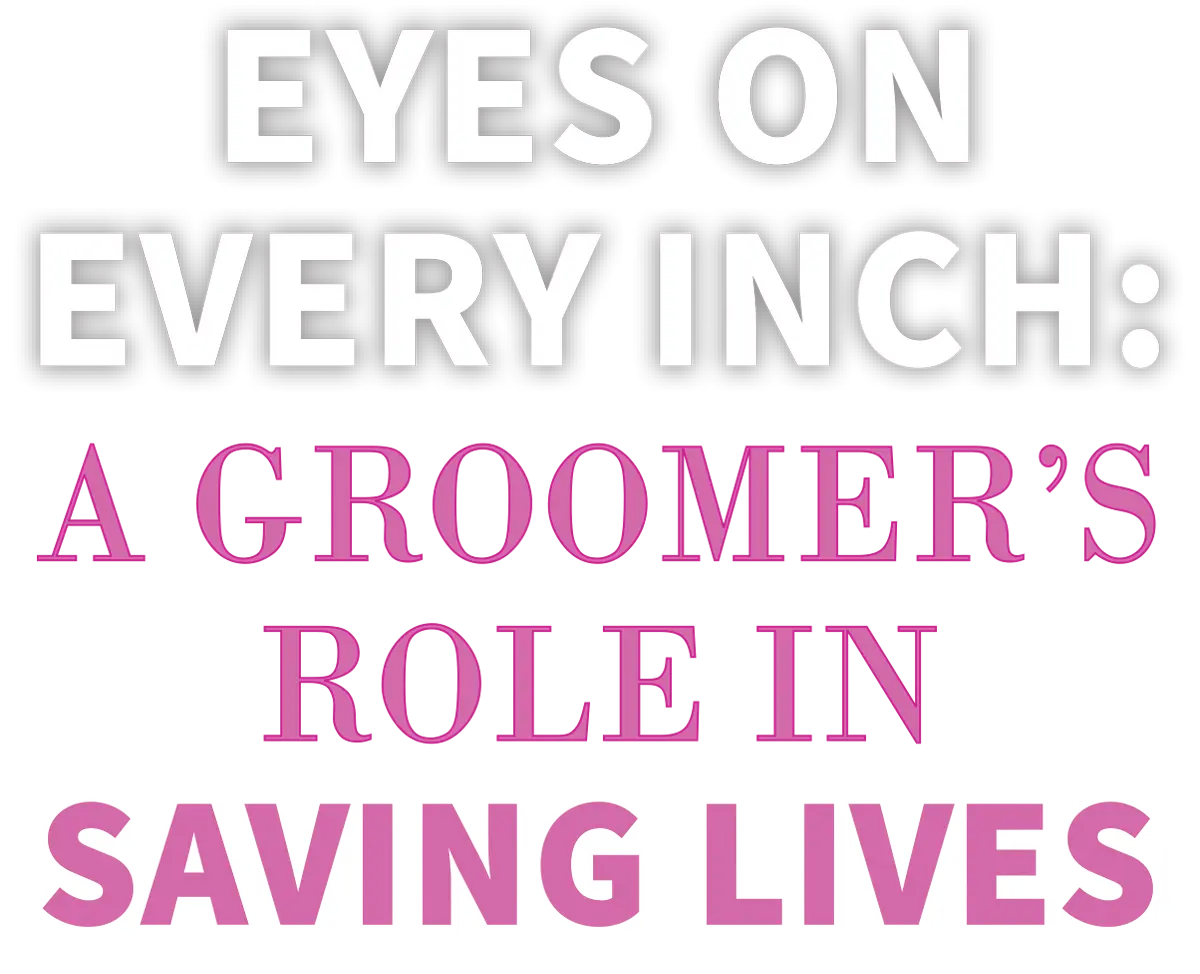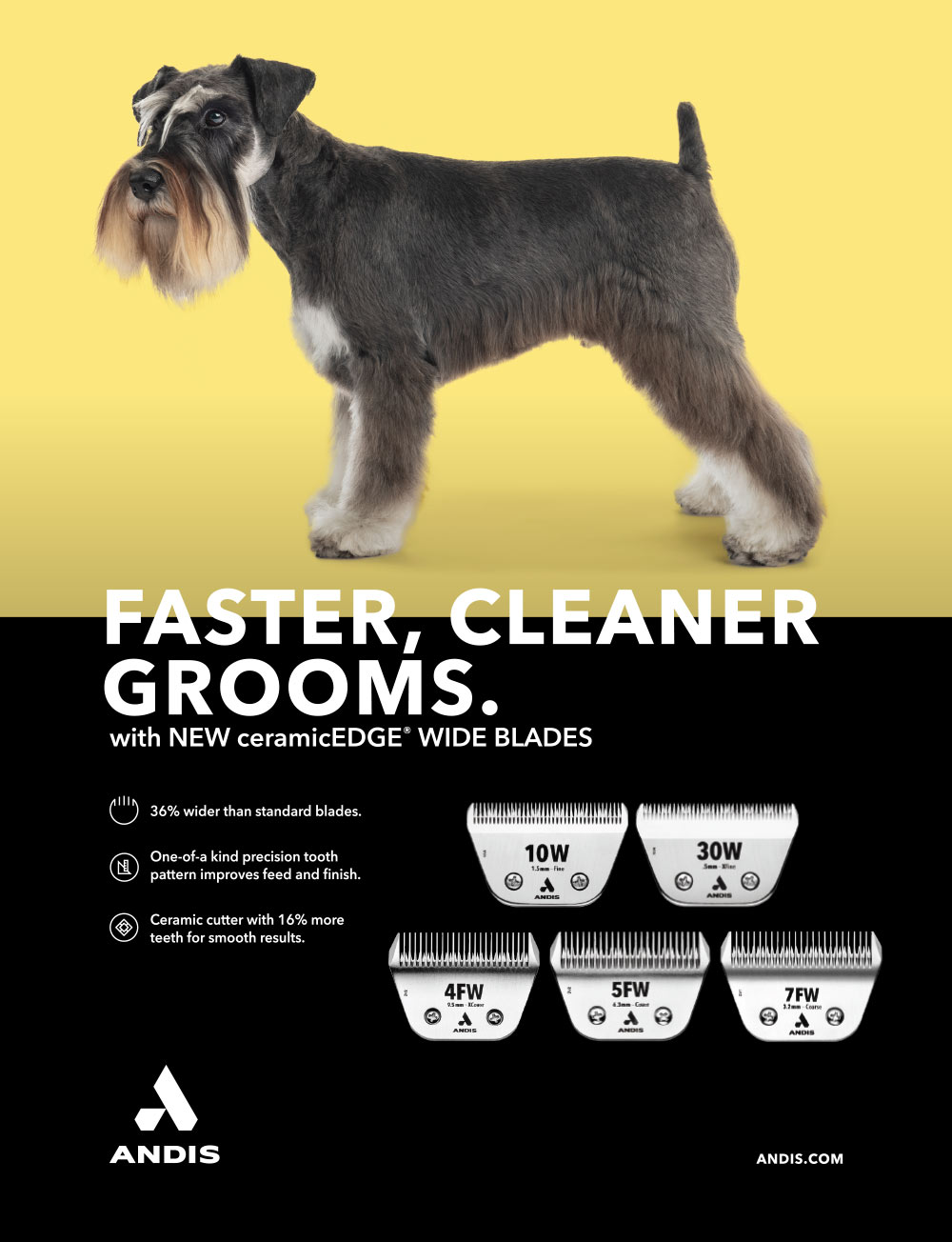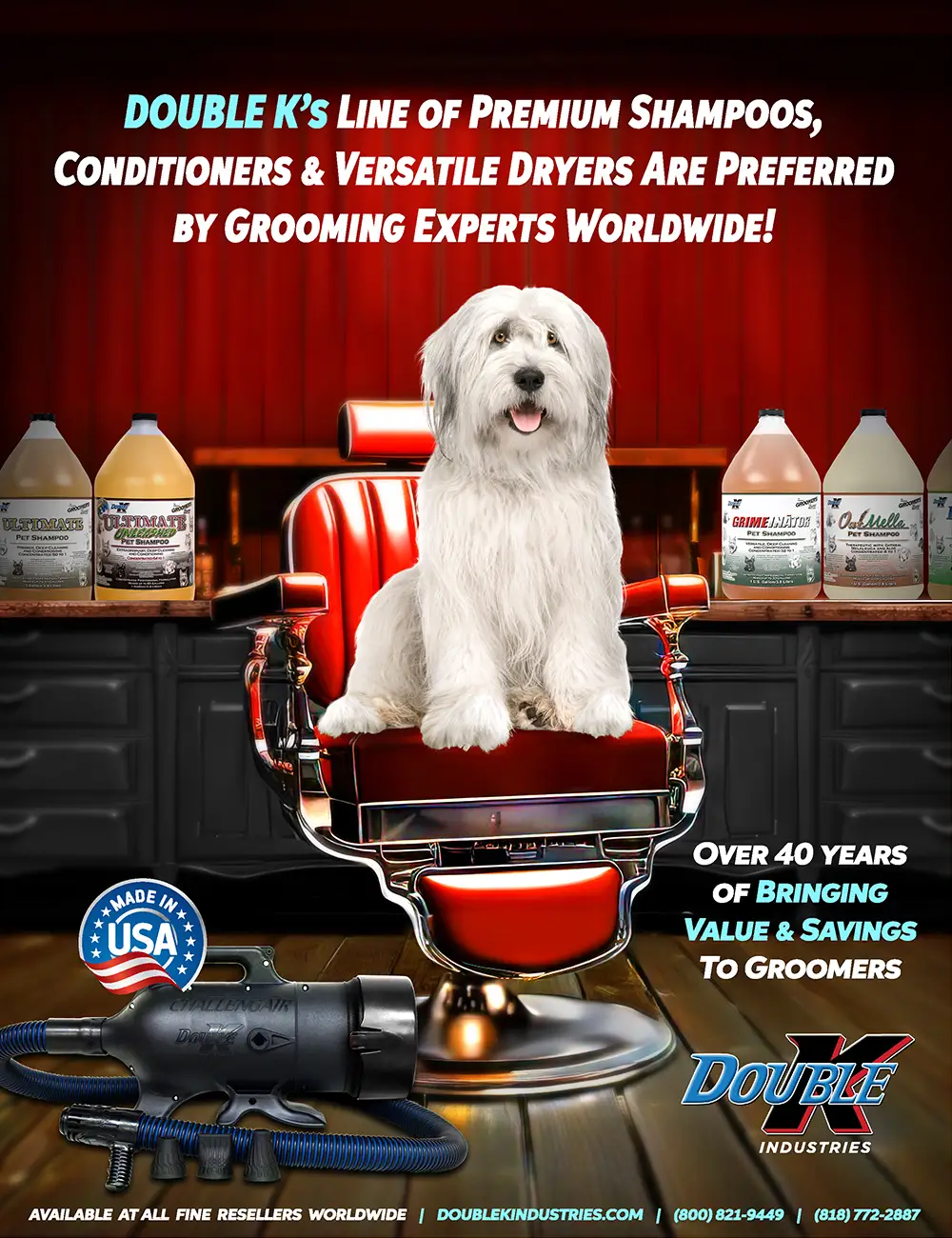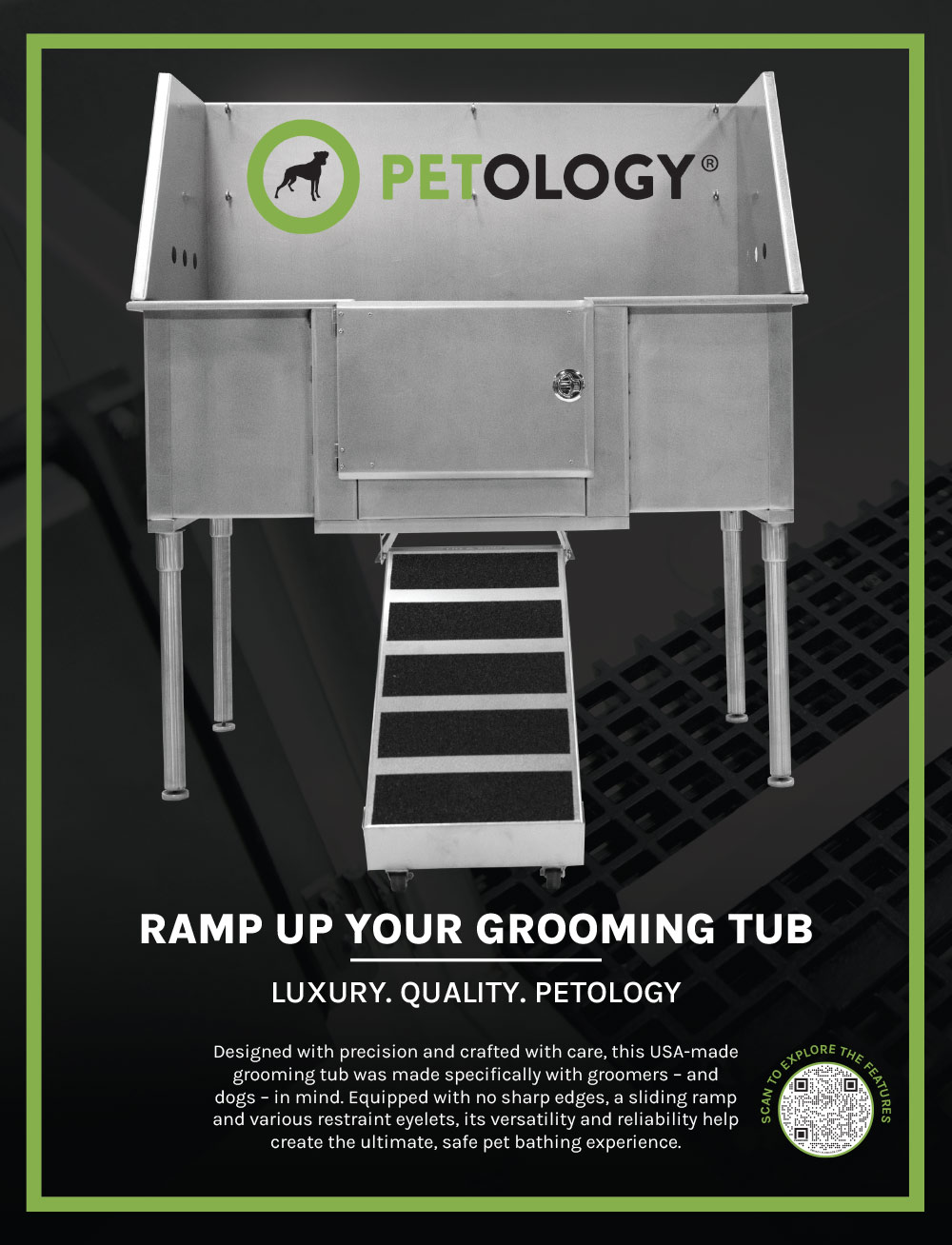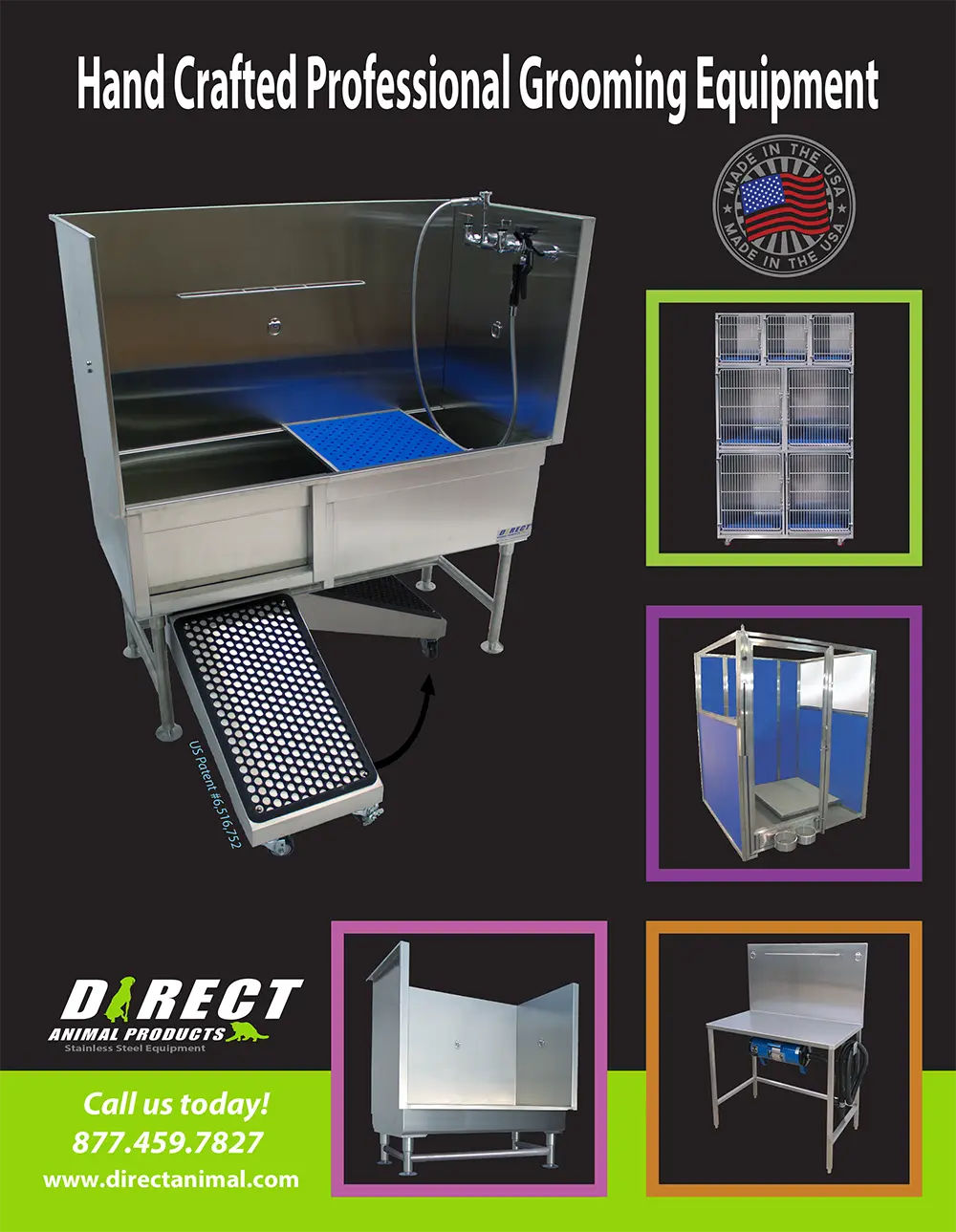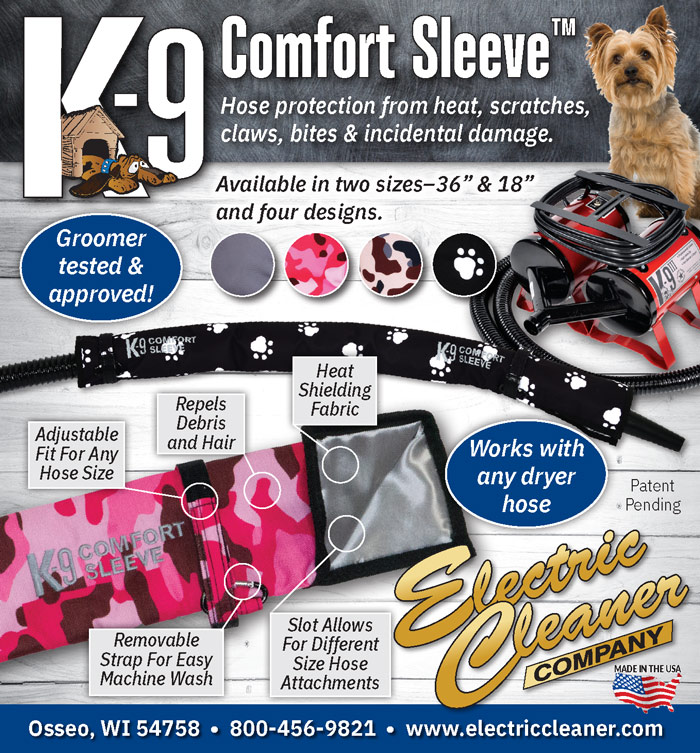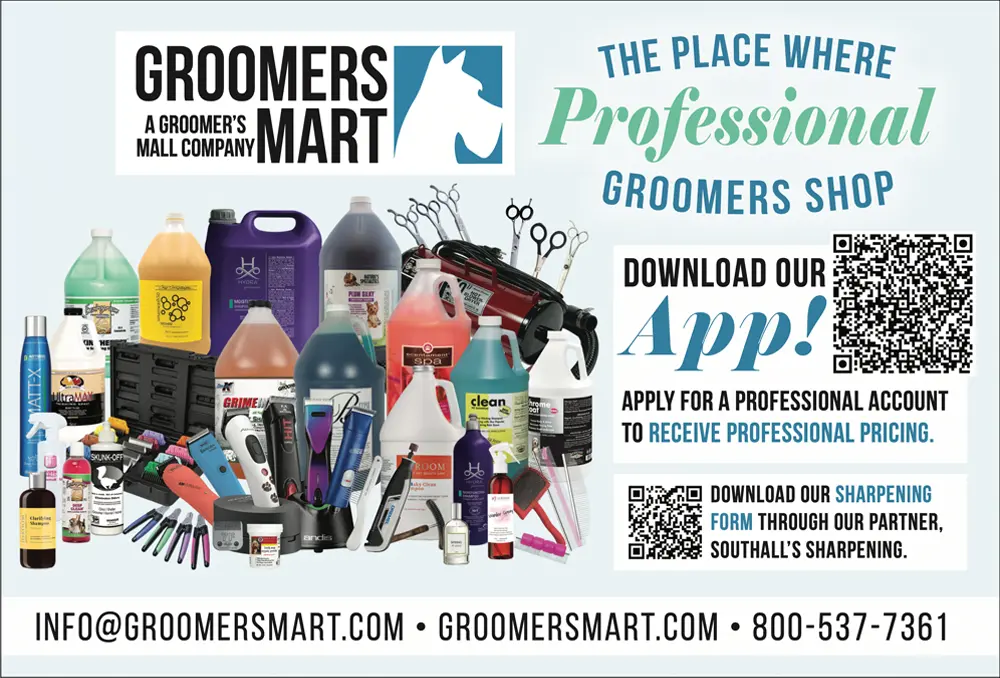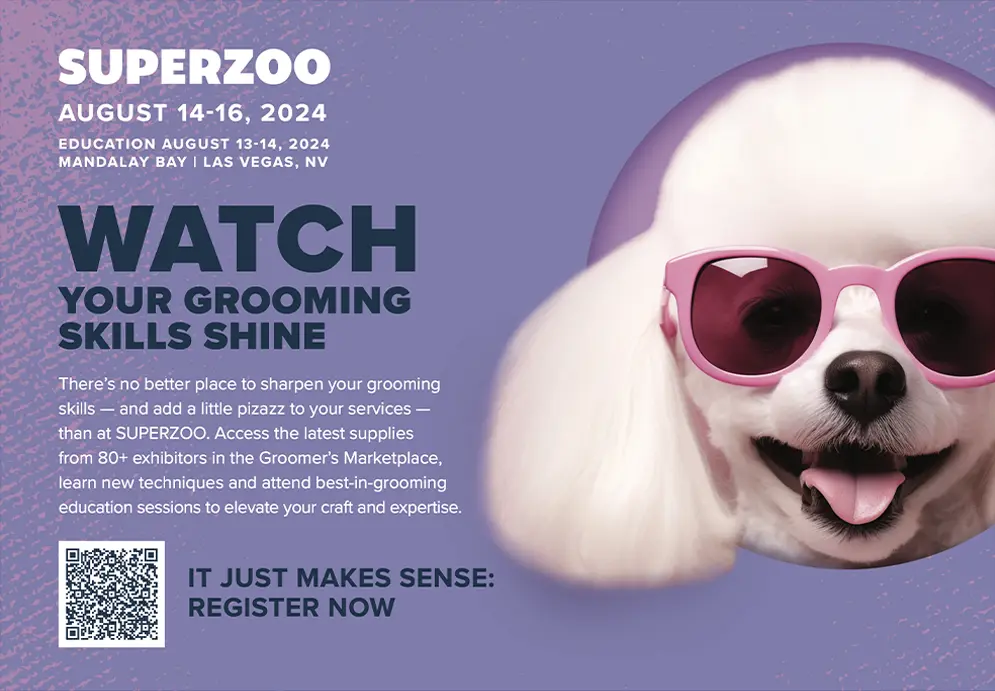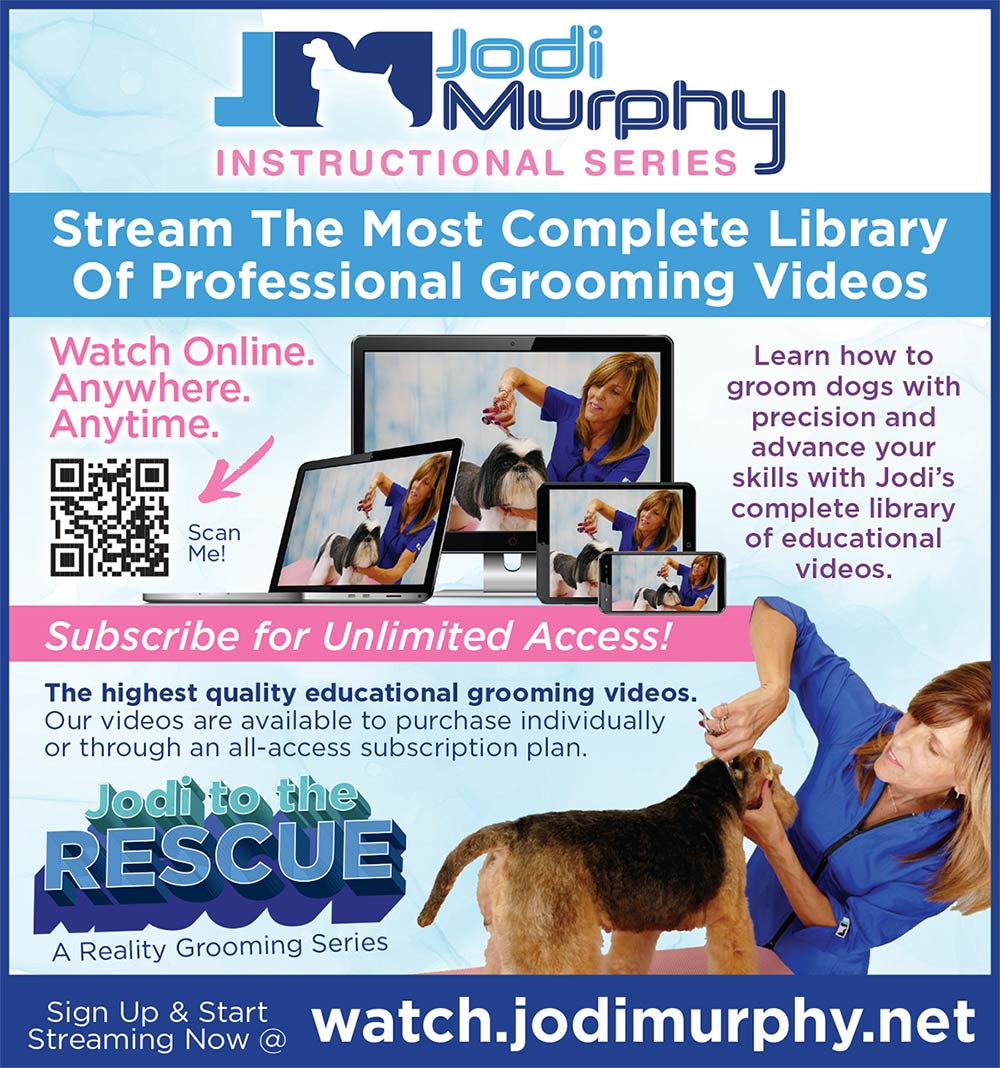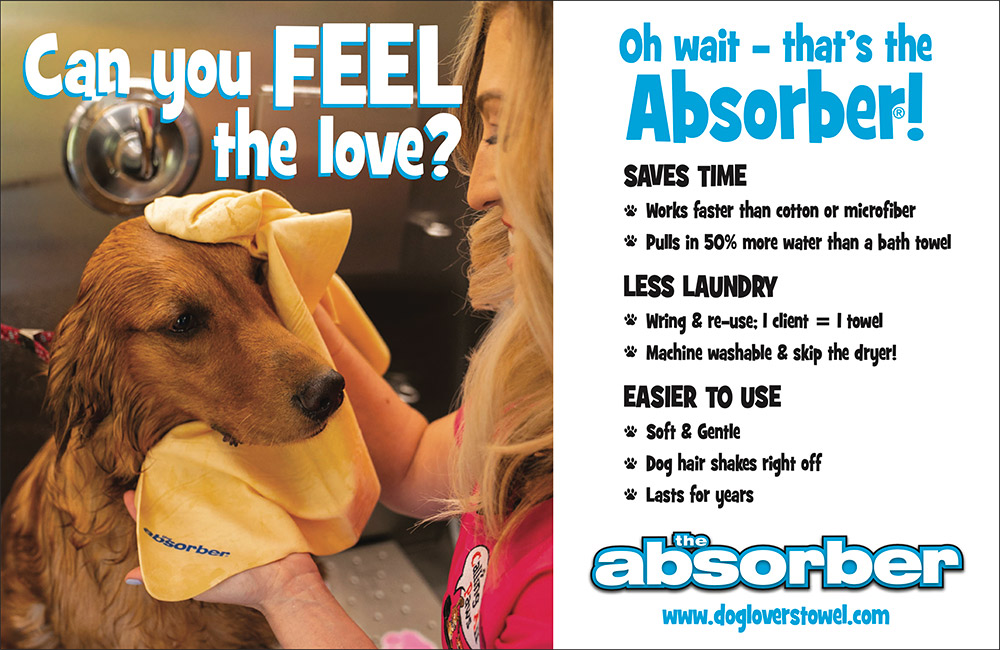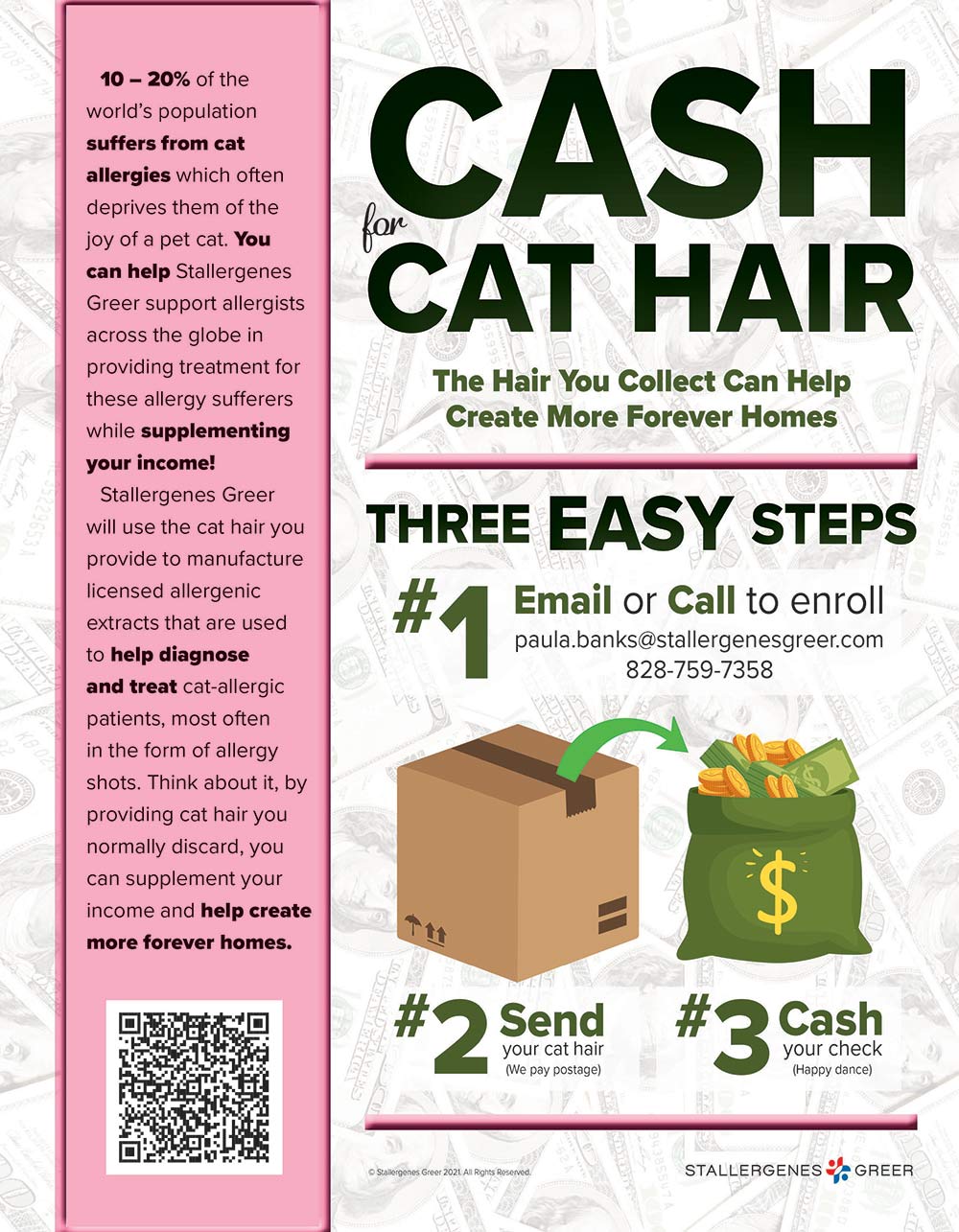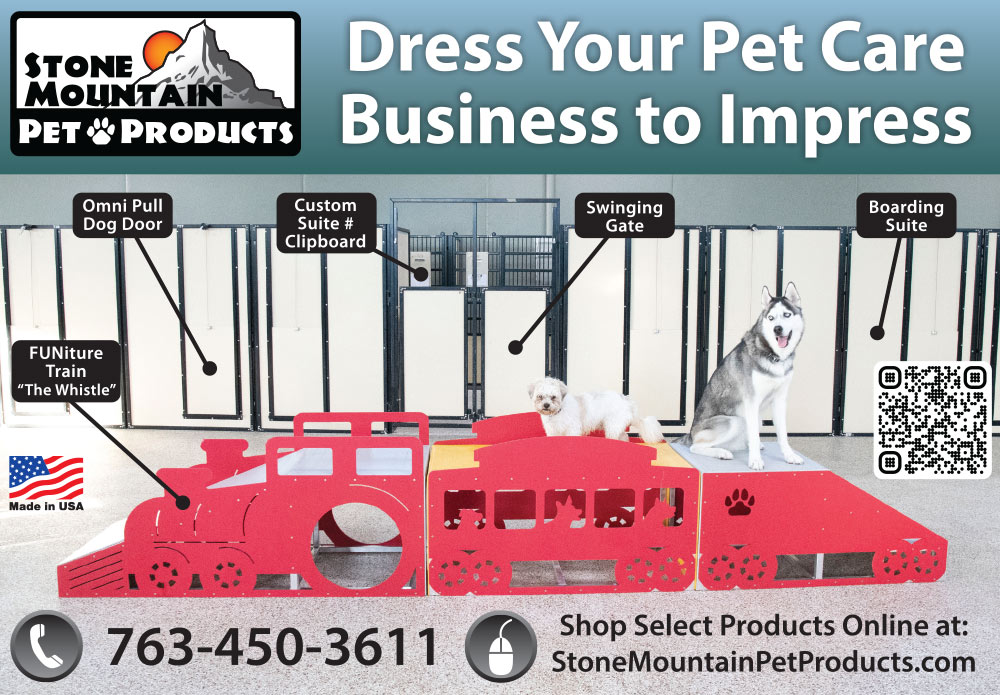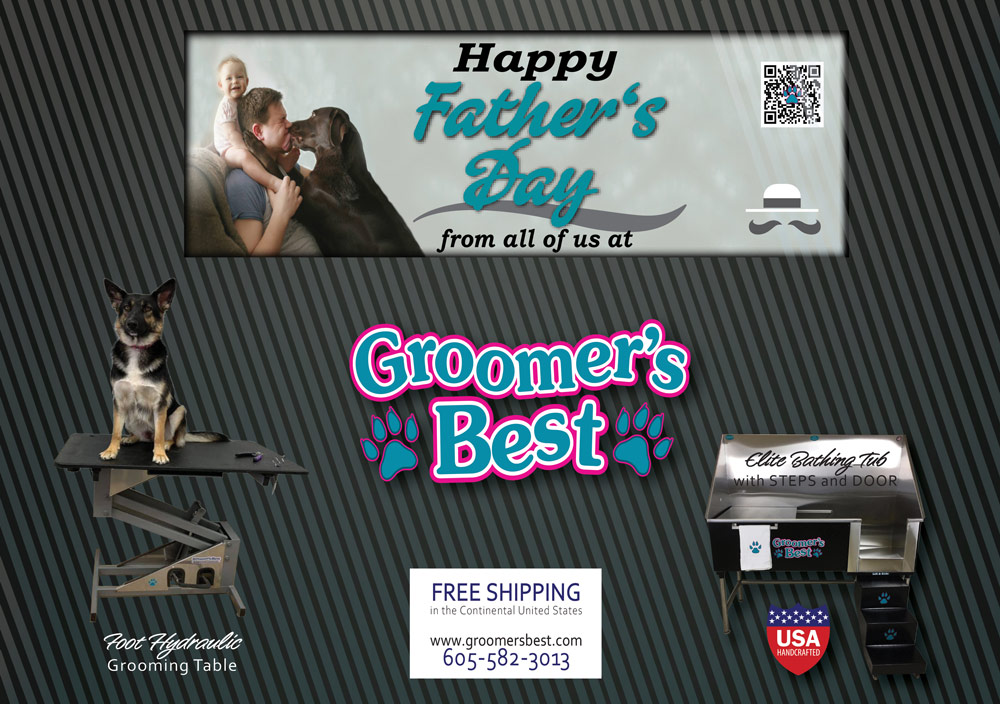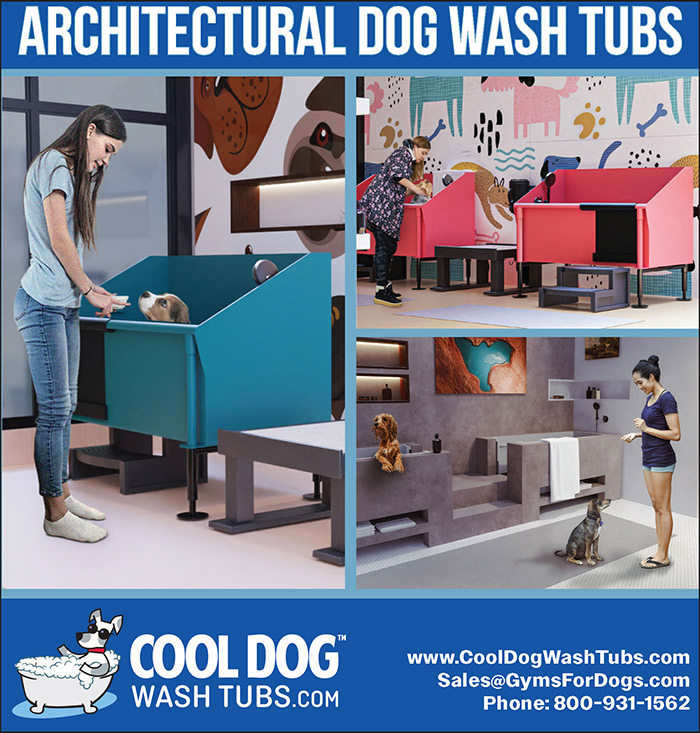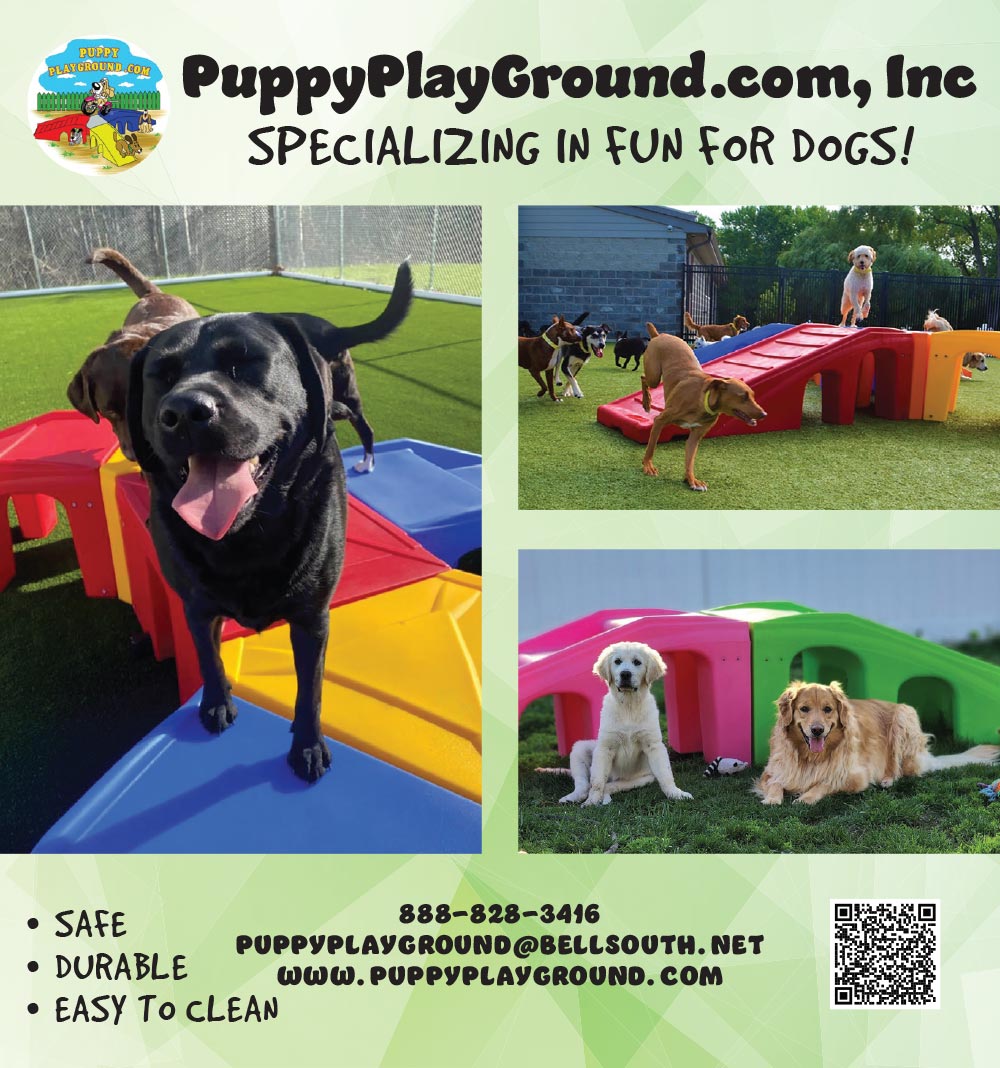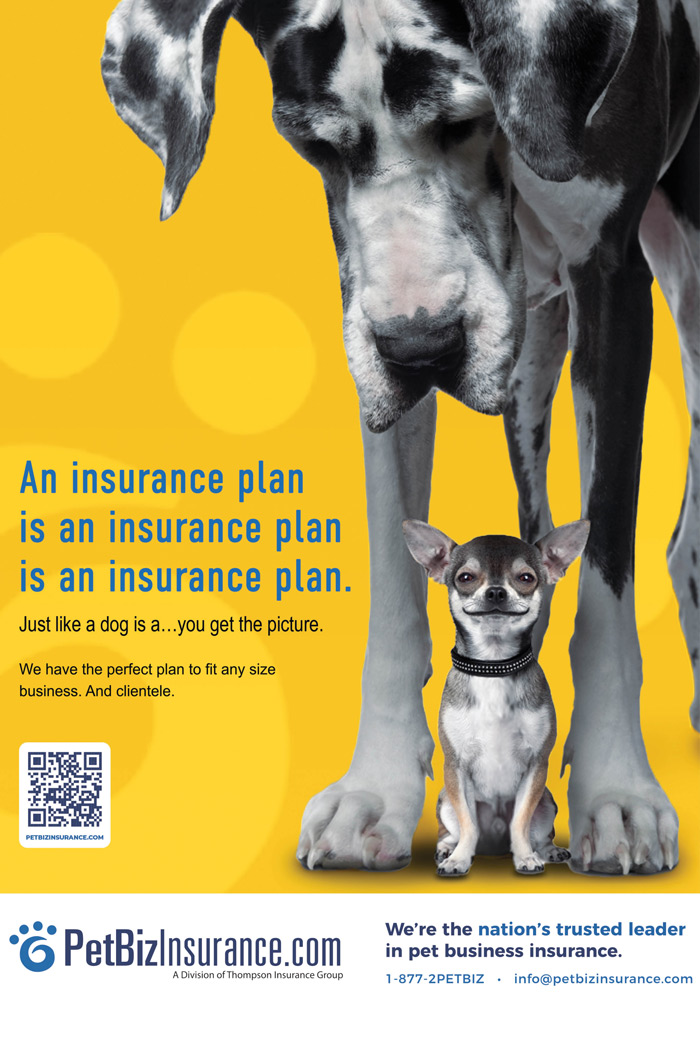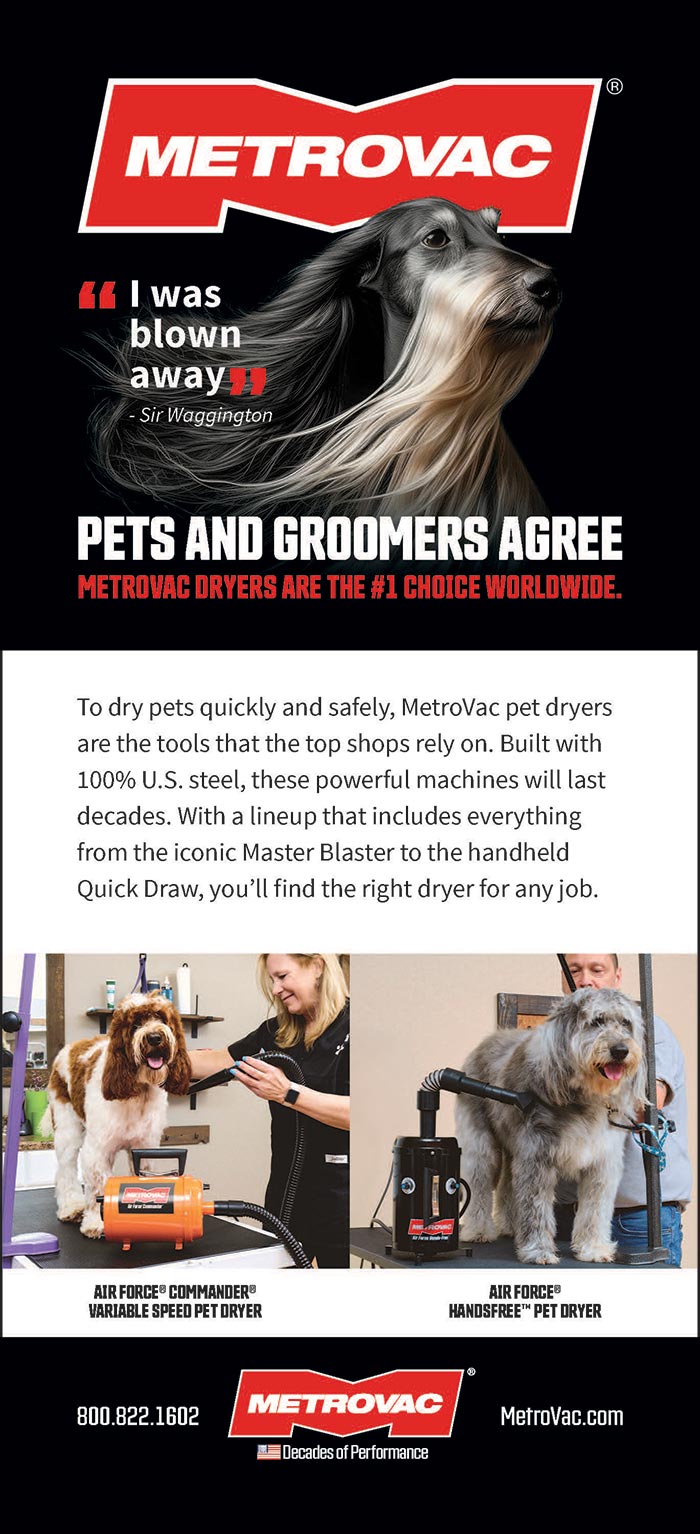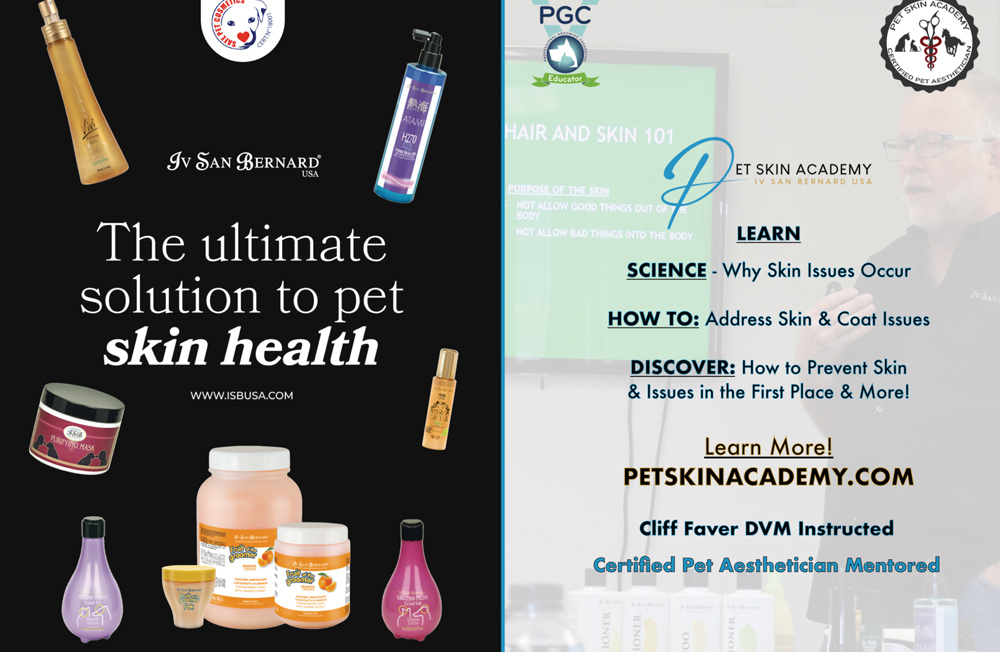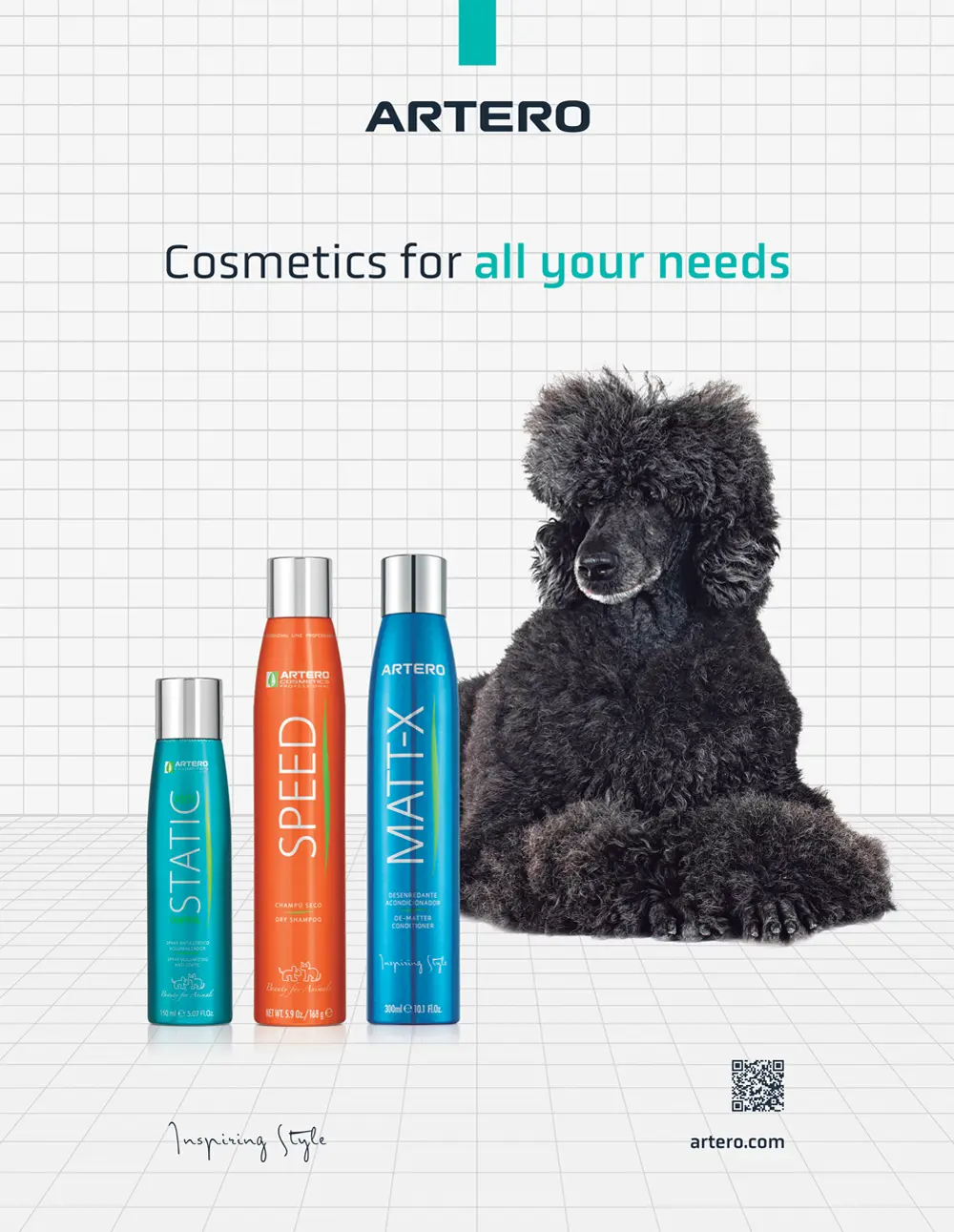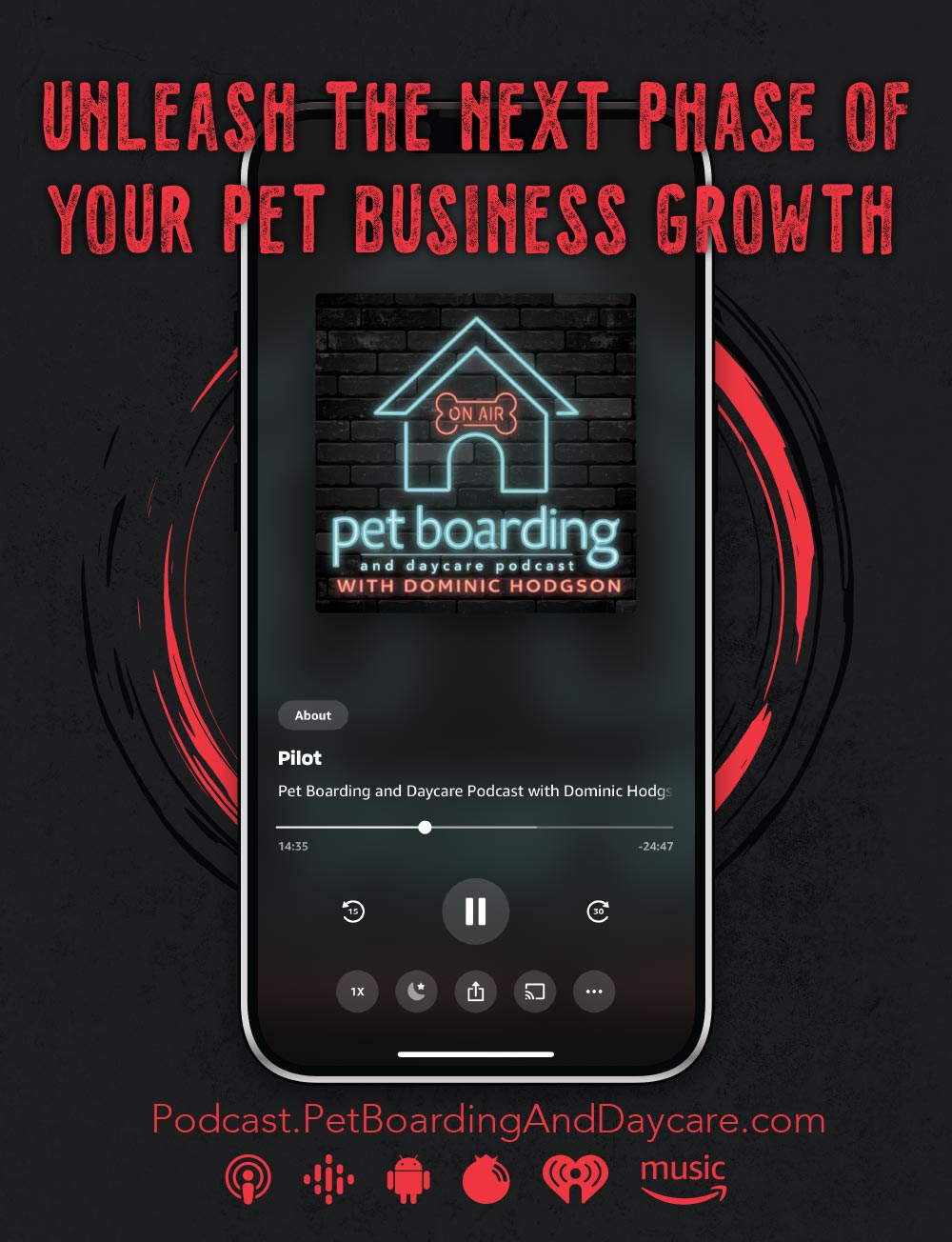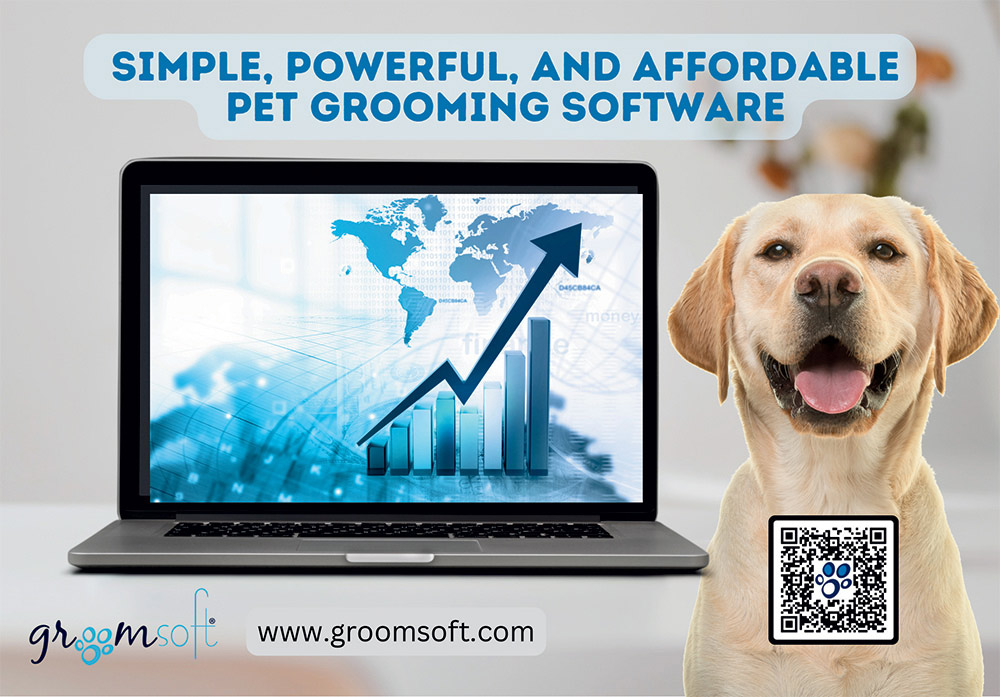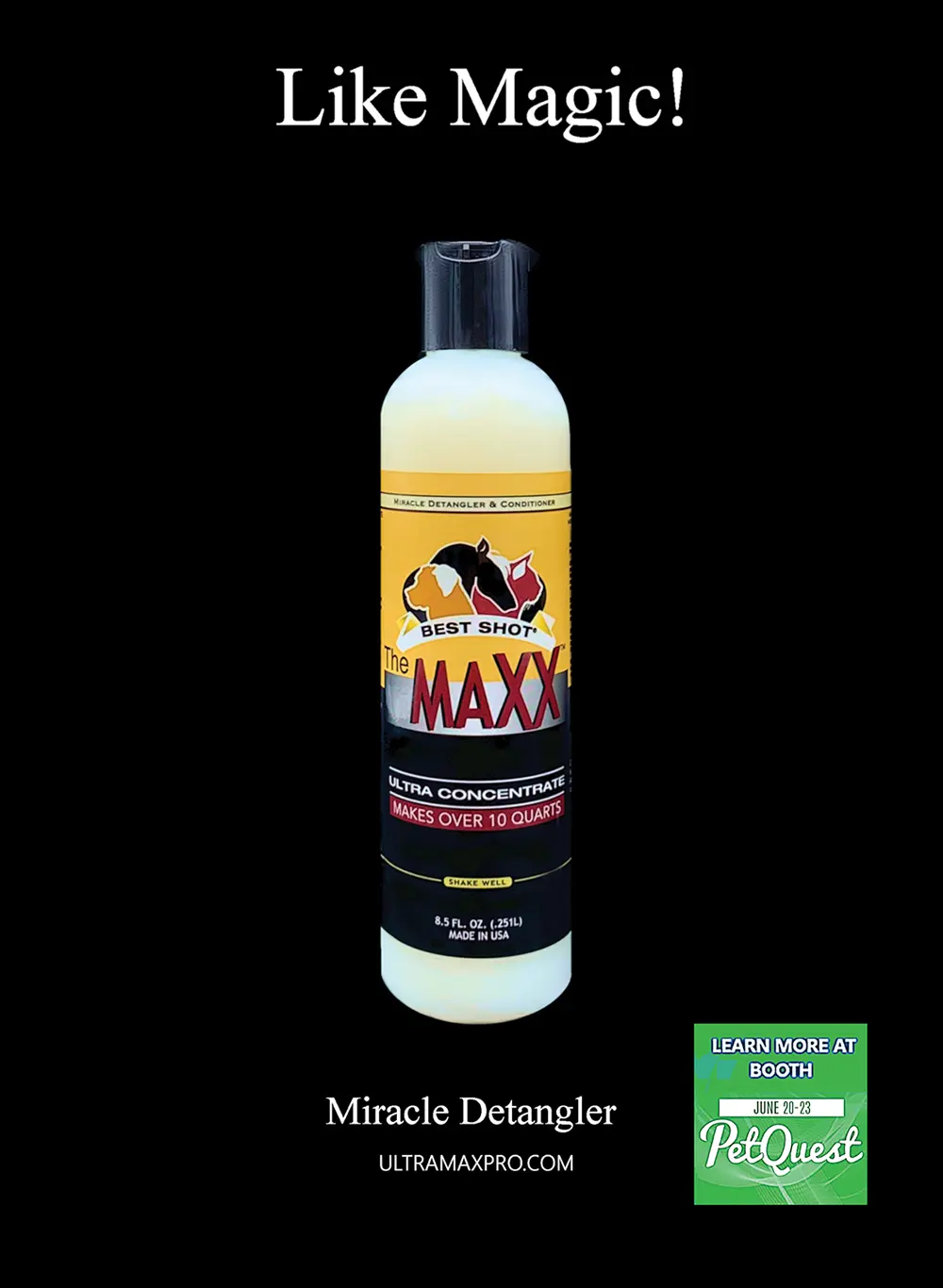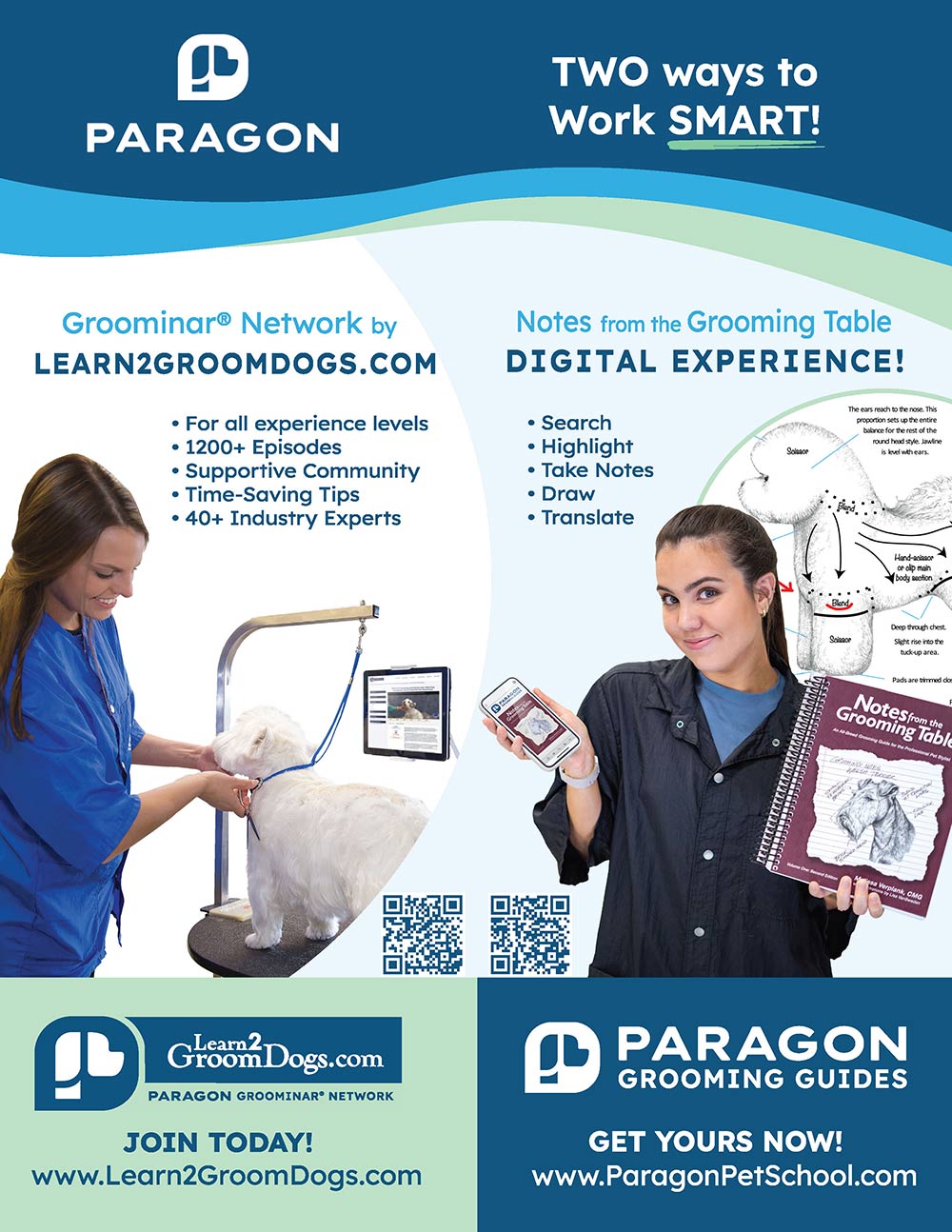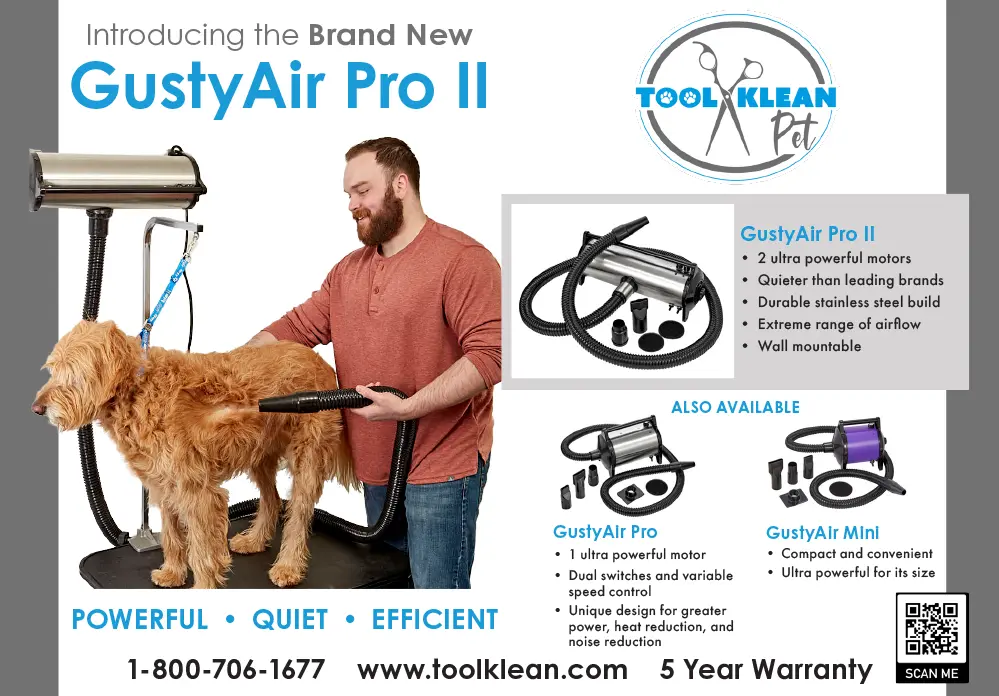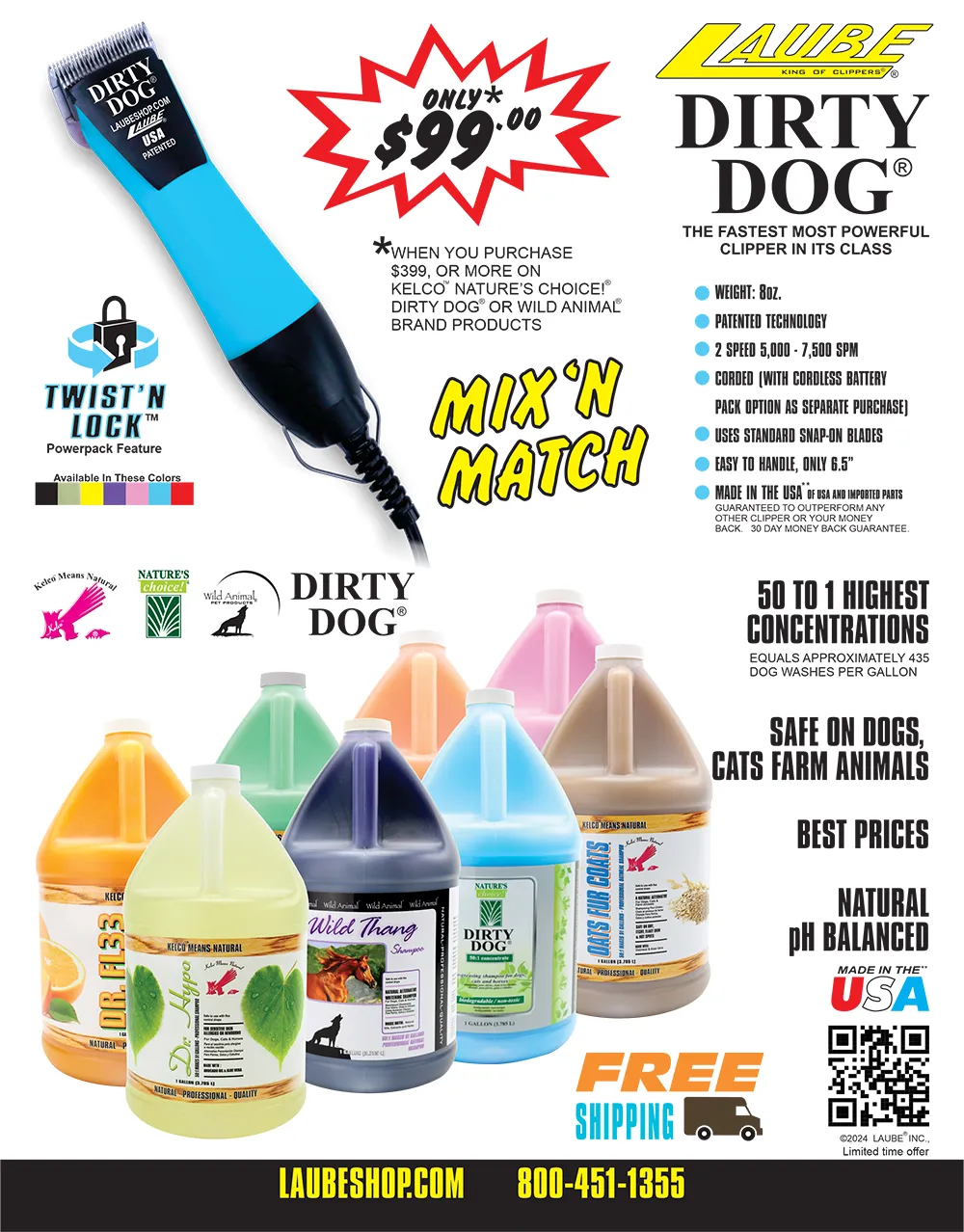Contents | June 2024
20
by Amy Addington
30
by Daryl Conner
ALSO INSIDE
todd@barkleigh.com
adam@barkleigh.com
gwen@barkleigh.com
rebecca@barkleigh.com
luke@barkleigh.com
laura@barkleigh.com
brandi@barkleigh.com
carlee@barkleigh.com
evan@barkleigh.com
cassidy@barkleigh.com
allison@barkleigh.com
james@barkleigh.com
karin@barkleigh.com
britany@barkleigh.com
Daryl Conner
Lynn Paolillo
Jennifer Bishop Jenkins
ALSO INSIDE
ON THE COVER
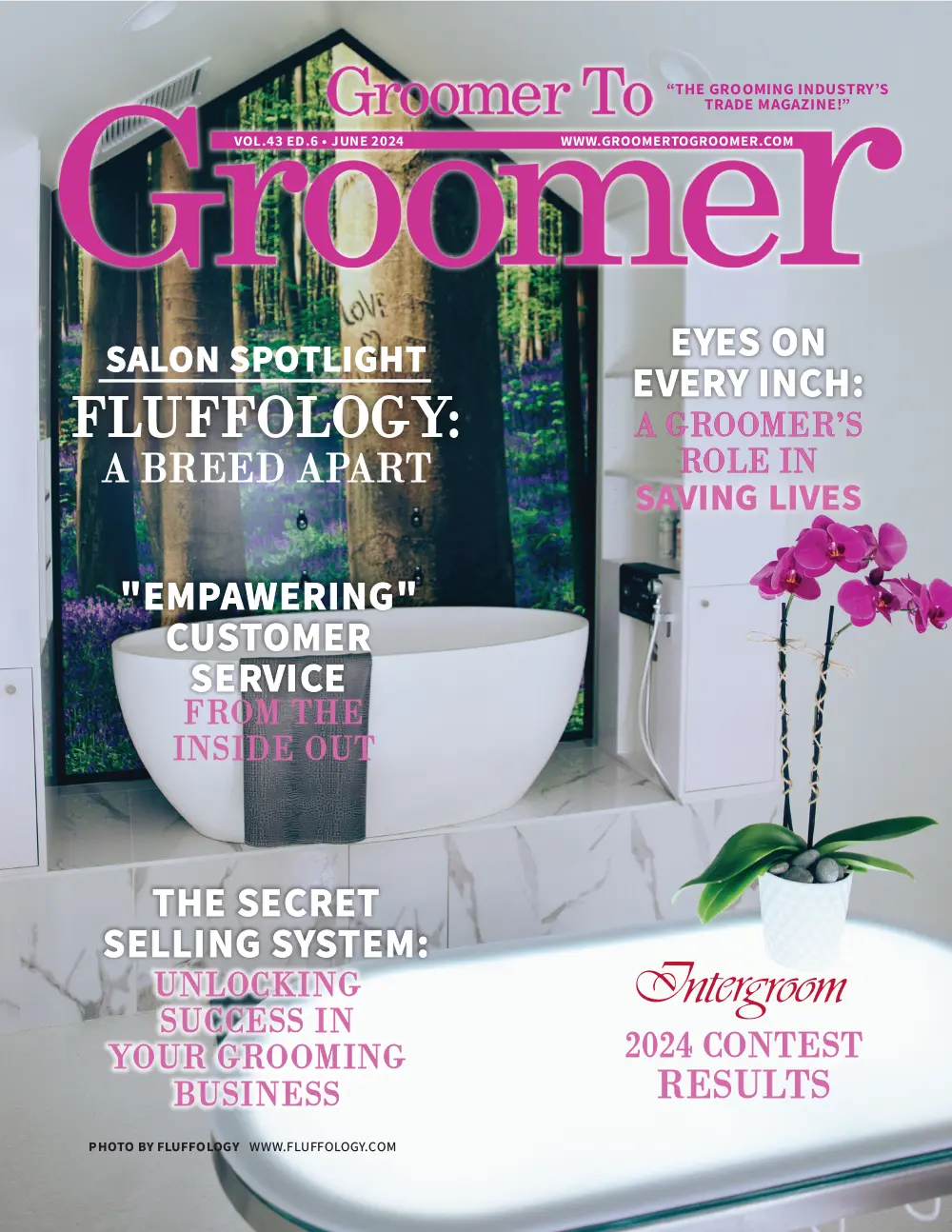
its advertisers for their continued support.
- All American Grooming Show39
- Andis2
- Animal Photography60
- Animals Ink32
- Artero49
- Bandanas Unlimited50
- Best Shot Pet23
- Best Shot PetDigital
- Cool Dog Wash Tubs41
- Cosmos Bathing Systems59
- Direct Animal Products9
- Double K Industries3
- Electric Cleaner Company18
- Envirogroom | Special FX Pet19
- Evolution Shears8
- Groomer’s Best38
- Groomers Mart21
- Groomsoft54
- Iv San Bernard | Pet Skin Academy47
- Jodi Murphy26
- Laube63
- Metrovac46
- Midmark31
- Paragon53
- Pet Biz Insurance45
- Pet Boarding Podcast51
- Pet’s Playground Grooming School17
- Petology4
- Puppy Playground42
- Quadruped Pet Care43
- Ryan’s Pet Supplies64
- Ryan’s Pet SuppliesDigital Only
- Stallergenes Greer27
- Stone Mountain Pet Products33
- Superzoo22
- The Absorber Dog Lover’s Towel28
- Thornell Odorcide29
- Tool Klean7
- Tool Klean58
- Wag’n Tails13

by Dr. Cliff Faver
 he grooming industry is at a crossroads, grappling with questions about its core identity and purpose. Are groomers merely service providers fulfilling client requests, or are they professionals dedicated to educating clients and prioritizing the wellbeing of pets?
he grooming industry is at a crossroads, grappling with questions about its core identity and purpose. Are groomers merely service providers fulfilling client requests, or are they professionals dedicated to educating clients and prioritizing the wellbeing of pets?
This ongoing debate reflects a broader shift in the pet care landscape, where the focus is increasingly moving towards responsible and informed pet ownership. At the heart of the discussion lies the dynamic between groomers and their clients. Groomers often find themselves torn between accommodating client demands and upholding professional standards. While it’s essential to listen to clients and address their concerns, it’s equally crucial for groomers to assert their expertise and advocate for the wellbeing of pets. However, navigating this balance can be challenging, particularly when faced with clients who may not fully understand the intricacies of pet care.
![Dark brown thin outline rectangular stroke around [this stroke has two dark brown trapezoid shapes hanging onto the top of the stroke] a pullquote that reads in dark brown - Ultimately, groomers must prioritize animal welfare above all else, even if it means [the next part after this portion of the phrase is in bolded dark gold] challenging client expectations.](https://digital.groomertogroomer.com/assets/2024/05/gtg_june24-service_profession-quote_01_graphic.webp)
Ultimately, groomers must prioritize animal welfare above all else, even if it means challenging client expectations.
Central to the debate is the issue of education. Many pet owners may lack the knowledge and experience necessary to make informed decisions about their pet’s care. Unlike groomers, who undergo training and gain expertise in pet grooming, clients may not fully grasp the consequences of their actions. This underscores the importance of education in the grooming industry, both for groomers and their clients.
Groomers play a vital role in educating clients about proper grooming techniques, product usage and preventive care measures. By sharing their knowledge and expertise, groomers empower clients to become more proactive in caring for their pet’s health and wellbeing. This not only strengthens the client-groomer relationship, but also ensures better outcomes for pets in the long run.
Moreover, educated clients are more likely to recognize potential issues early on and seek professional help when needed. They understand the value of preventive care and are willing to invest in products and services that promote their pet’s health and happiness. As a result, groomers can focus on providing quality care rather than remedying preventable problems caused by misinformation or lack of awareness.
As professionals, groomers have a responsibility to advocate for animal welfare and uphold ethical standards in their practice. This means prioritizing the wellbeing of pets above all else and taking proactive steps to ensure their safety and comfort. While it’s essential to respect client preferences, groomers must also recognize when certain requests may compromise the health or safety of the pet.
In some cases, groomers may feel pressured to comply with client demands, even when they know it’s not in the pet’s best interest. However, it’s crucial for groomers to assert their expertise and communicate openly with clients about the potential risks involved. This requires courage and conviction but, ultimately, it’s the only way to uphold professional integrity and ensure the welfare of the animals under their care.
![Dark brown thin outline rectangular stroke around [this stroke has two dark brown trapezoid shapes hanging onto the top of the stroke] a pullquote that reads in dark brown - Ultimately, groomers must prioritize animal welfare above all else, even if it means [the next part after this portion of the phrase is in bolded dark gold] challenging client expectations.](https://digital.groomertogroomer.com/assets/2024/05/gtg_june24-service_profession-quote_02_graphic.webp)
By prioritizing education, advocating for animal welfare and fostering open communication with clients, groomers can navigate these challenges with confidence and integrity.

In conclusion, the grooming industry is undergoing significant changes, prompting discussions about its role and responsibilities in pet care. Groomers face a delicate balance between accommodating client preferences and upholding professional standards. However, by prioritizing education, advocating for animal welfare and fostering open communication with clients, groomers can navigate these challenges with confidence and integrity.
Ultimately, the wellbeing of pets should always remain at the forefront of the grooming profession, guiding every decision and interaction between groomers and their clients. As the industry continues to evolve, it’s essential for groomers to embrace their role as educators and advocates, shaping a future where pets receive the care and attention they deserve.
Dr. Cliff Faver graduated with a BS in Biology/BA in Chemistry before getting a Veterinary degree in 1987. He is the past owner of Animal Health Services in Cave Creek, Arizona and now the US distributor for Iv San Bernard products, teaches the ISB Pet Aesthetician Certification program, and speaks internationally on hair and skin. His passion is to merge groomers and veterinarians to aid in helping and healing pets. He is also a member of AVMA, AAHA, AZVMA, Board member with Burbank Kennel Club, and has served on Novartis Lead Committee, Hill’s International Global Veterinary Board, and a Veterinary Management Group.


A Breed Apart
by Jen Phillips April
Photos provided by Fluffology
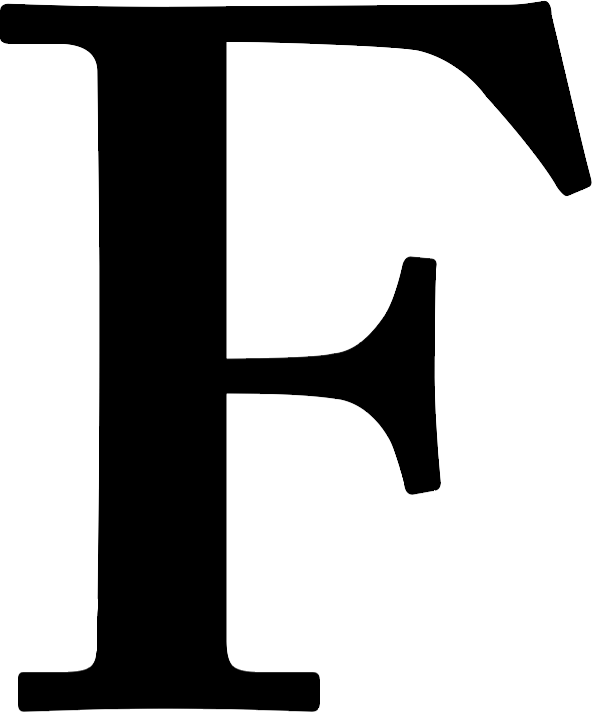 luffology in North Hollywood, California may be the first dog grooming salon to have a Director of Grooming and Education. Yet, that’s not the only thing that sets it apart. The salon also aims to bring the best to pet parents and their furry clientele by offering one-on-one grooming in private suites where pet parents can watch their pets being groomed.
luffology in North Hollywood, California may be the first dog grooming salon to have a Director of Grooming and Education. Yet, that’s not the only thing that sets it apart. The salon also aims to bring the best to pet parents and their furry clientele by offering one-on-one grooming in private suites where pet parents can watch their pets being groomed.
“I conceived the entire store with a purpose every step of the way,” says Fluffology’s founder, Kimberly Weiner. “Our grooming suites are designed so pet parents can see what we’re doing. I never liked dropping my dog off at 8:30 in the morning and picking him back up at 4:00 behind closed doors. Being kept in a room that long with other dogs increases his anxiety and my uncertainty.”
The inspiration for Fluffology was born when Kimberly took her standard Poodle to a big-box store to buy food and other necessities. Disappointed with the lack of specialized knowledge, she went home and turned to the internet, which was another disappointment…
Kimberly says Fluffology’s two core pillars are grooming and health & wellness. In addition to offering a well-curated selection of accessories in their retail area, they also make in-house, single-ingredient, organic treats and chews. “We now make them and package them under our own brand to give folks options when they come in for a groom or to provide a treat for their pet while they’re here,” she adds.
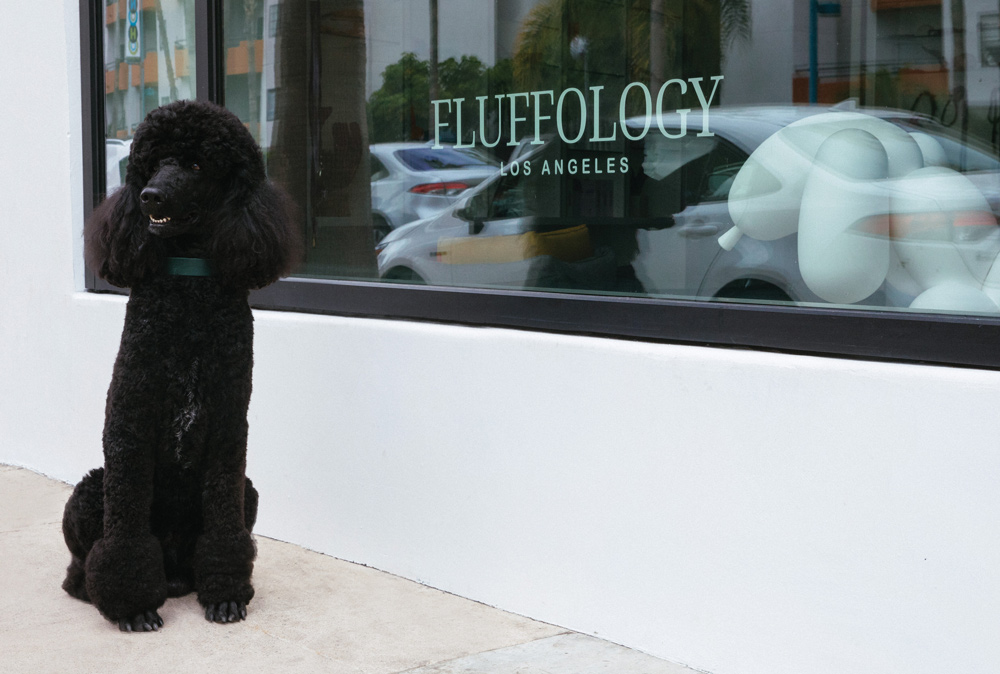
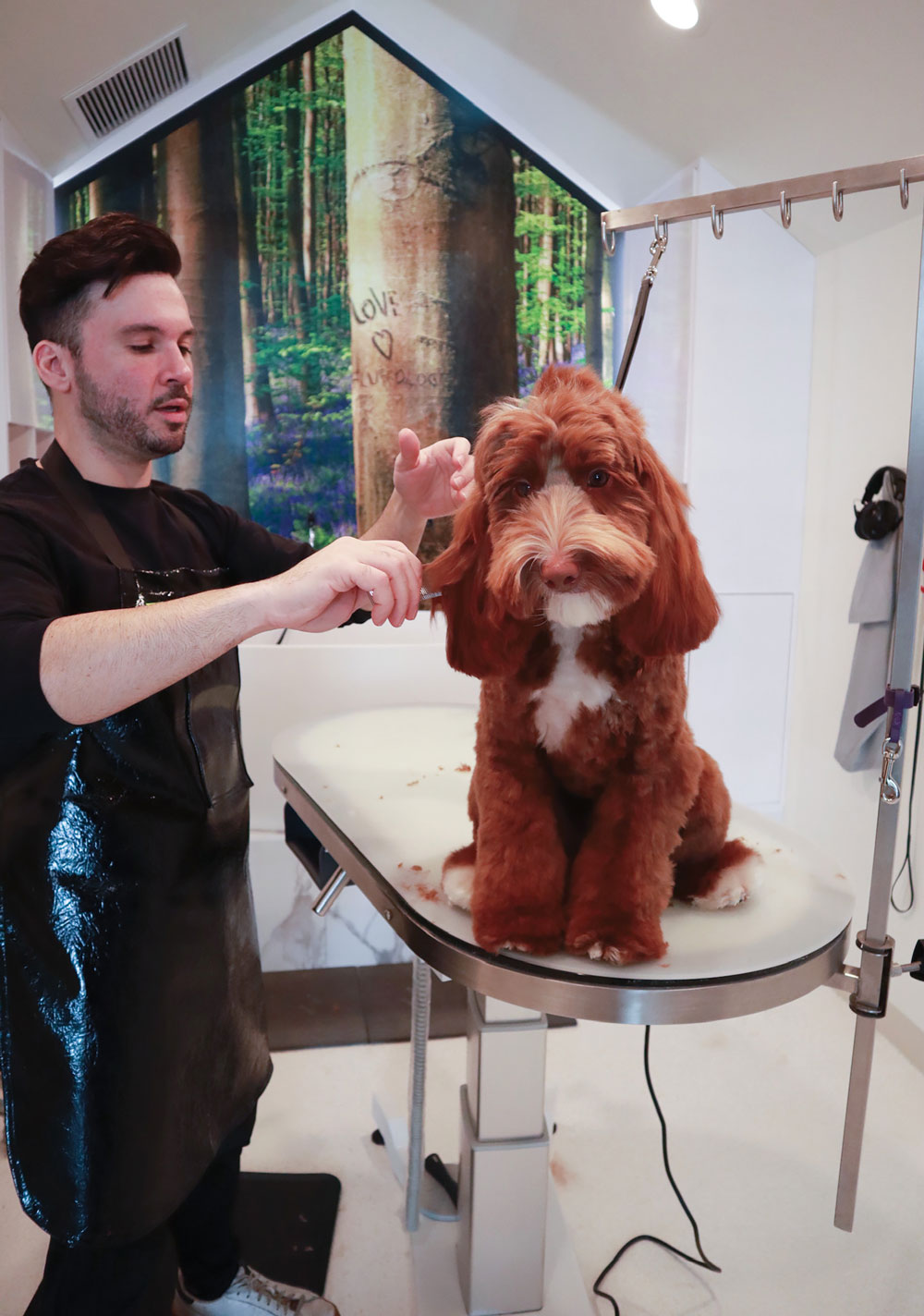
-Kimberly Weiner
“I do a lot of education, and I was a competition groomer for many years and have been a part of many pet-related associations,” Liz shares. “For me, being a part of Fluffology was important because Kimberly wanted to make sure that it was an all-inclusive experience for the customer, and I take grooming very seriously.”
Liz spends her days in hands-on training with the four stylists as the “quality check” for every dog. “This is my life. I love it so much and want Fluffology to be the best it can be,” she exclaims. “All pet parents deserve educated, knowledgeable, safe, and CPR-certified stylists. We want our stylists to feel proud of their work.”


-Liz Hampton, Fluffology’s Director of Grooming and Education
Aside from investing in quality, Fluffology invests in beauty, too. And this means top-of-the-line equipment, including human tubs made of soft quartz. “The aesthetic is absolutely beautiful; it’s definitely elevated as far as traditional grooming,” Liz says.
“But one of the biggest differences is the low stress level because all grooming is done quietly, one-on-one,” she continues. “Additionally, the fact that the owners can watch the entire process and see everything is resonating very, very well.”

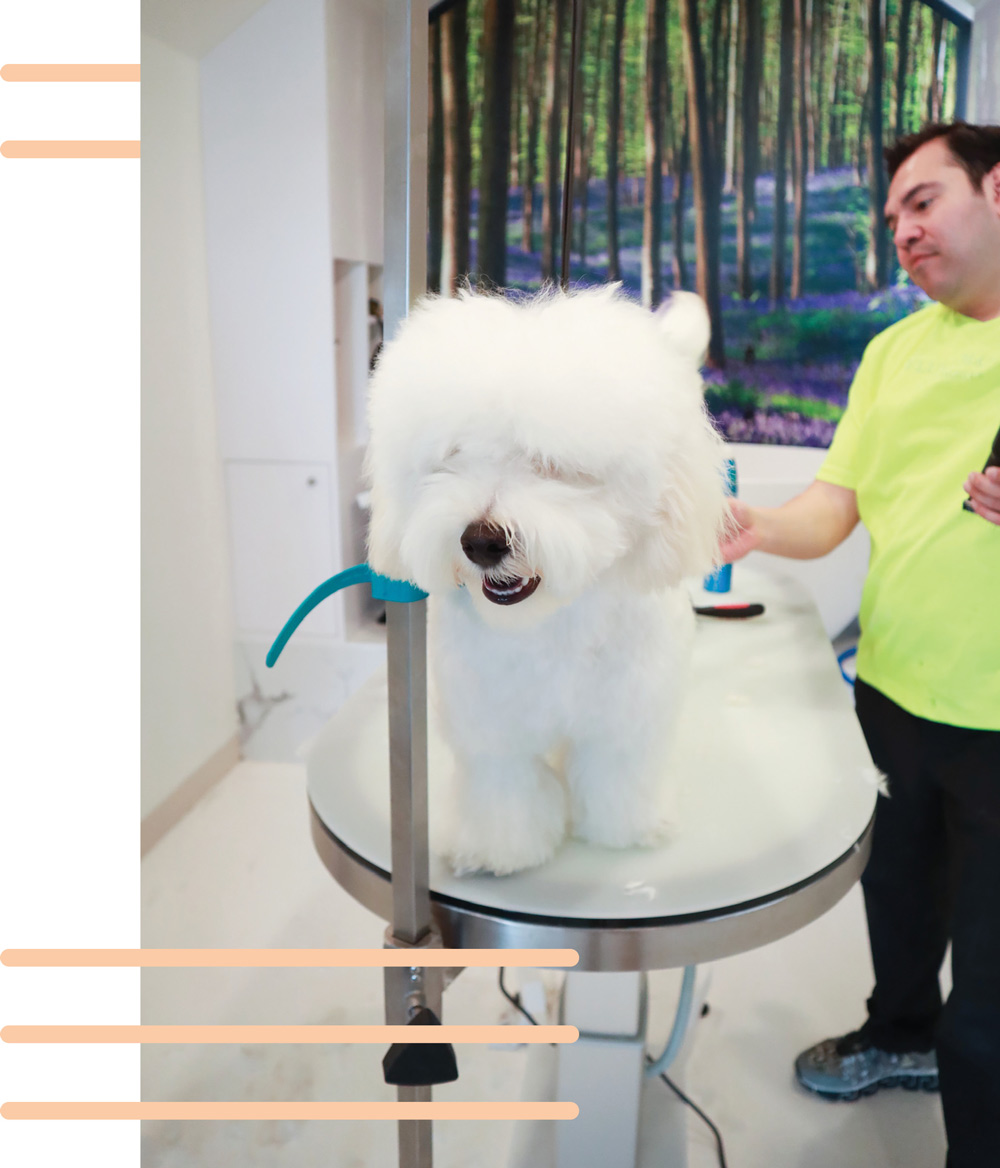
Nearing their one-year anniversary, Fluffology only just opened in June of 2023, and Kimberly and Liz said it’s been much harder to change people’s perceptions of dog grooming and build a brand than they anticipated. “I was a little naive, you know. I thought, build it and they’ll come. Not necessarily…” Kimberly says emphatically.
However, things are definitely moving in the right direction, as they’ve already had customers pre-pay for the year. In addition, they will soon be expanding their menu of services when they welcome their resident behaviorist on board. “We are thrilled to be fortunate enough to have found Erik Hall, a recent graduate of the most innovative, cutting-edge training program created out of the UK,” Kimberly shares. “Our pet parents can rest assured that their pets will be on their way to behaving like little angels.”

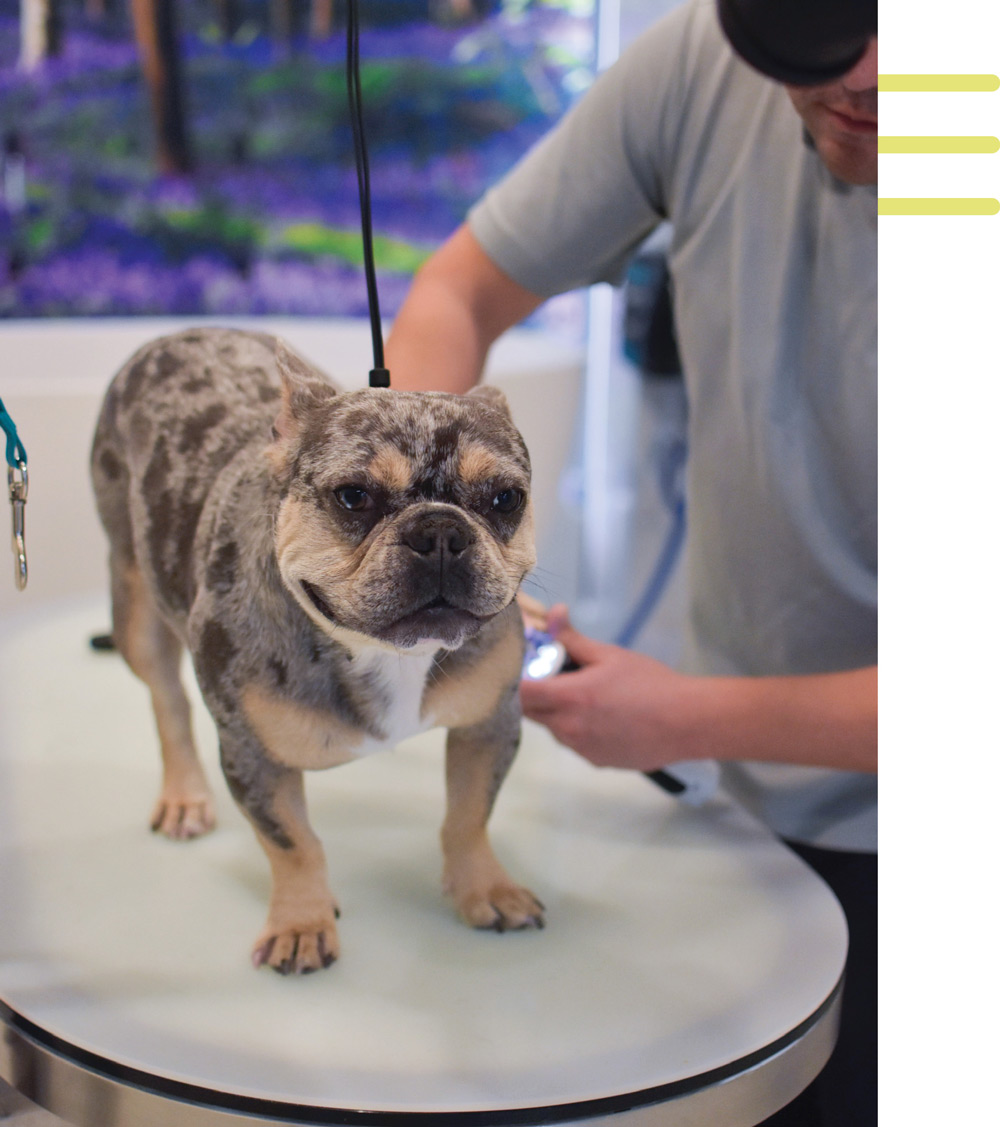
– Kimberly Weiner
This determination combined with a commitment to quality and whole-pet health is what sets Fluffology “a breed apart” from grooming salons everywhere.



by Jennifer Bishop Jenkins
 have saved several dogs’ lives. I know this because their veterinarians told the dogs’ owners that I did and the owners called or came in to thank me. I have been the recipient of several tearful, grateful hugs during an in-person visit, often accompanied by flowers, a gift or a meal bought for my staff as a thank you presented with, “You saved my dog’s life!”
have saved several dogs’ lives. I know this because their veterinarians told the dogs’ owners that I did and the owners called or came in to thank me. I have been the recipient of several tearful, grateful hugs during an in-person visit, often accompanied by flowers, a gift or a meal bought for my staff as a thank you presented with, “You saved my dog’s life!”
I tell them I am happy we could help, but this is our job—caring for their dogs. More than anything else, the service we owe our customers is to safely and correctly groom their dog, while also catching any potential health or safety issues that might need attention.
So how do we accomplish this demonstrably life-saving feat? We simply use our eyes and hands to visually and manually inspect every inch of every dog that comes into the shop for grooming. With most dogs, we see nothing that needs reporting and we are happy to tell the customer so. Usually what we do find and report is not a matter of life or death but something minor such as a badly broken toenail, or sometimes a rash that turns out to be a yeast infection. Anything out of the ordinary that doesn’t look or feel normal or healthy should be reported to the customer either during or after the visit, depending on severity.
The best time to catch any kind of problem is during blow-drying. Whether you use high-velocity dryers, stand dryers or gentle hand-held dryers, you should never just cage-dry a dog completely. Drying time should be used to visually inspect every inch of every dog or cat you groom, looking between toes, in armpits, under ears, on the bottom of tails and in the insides of legs. We have caught foxtails embedded in the skin between toes that merely looked like a weird, tiny hole that, when squeezed, produced a little pus. In the worst case scenarios, an embedded foxtail can make it to vital organs, including the lungs, spinal cord or brain, heart and abdominal organs, causing symptoms specific to that organ.1
One wonderful, attentive and caring groomer working with me some years ago was styling a doodle’s bearded face. She was carefully trimming around mouth hairs, clearing up hairs sticking in the teeth, etc. While the dog’s mouth was open, she saw what looked like a very small piece of cauliflower in the back of the mouth. When she asked for help to take a second look, sure enough, it wasn’t a piece of food, it was a white lumpy growth at the back of the dog’s mouth.
We reported it to the owner and the loving family took her to the veterinarian immediately. Sadly, it was confirmed to be mouth cancer, but we caught it early. She went through treatment and, while years later it eventually came back and ultimately led to her passing at age 13, she lived years that she would not have otherwise. All because our eyes were on every inch of that dog and we reported something that was out of the ordinary.
Since veterinarians typically see healthy dogs perhaps once a year and owners don’t usually examine their dogs closely on a regular basis, we groomers are often the first line of defense for our clients. We should touch every area of a dog’s body in a gentle, loving way, feeling for lumps, tender spots, scratches, mats, foreign objects (one time we found a fishing hook inside a mat on a doodle!) and anything else out of the ordinary. Record details of what is normal for the dog in your notes about each client.
Very early in my shop’s first year, I groomed a very sweet nine-year-old shepherd mix. I was just running my hands over her and one of her rear leg thigh muscles felt noticeably thicker than the other. Nothing else seemed to be wrong and she wasn’t touchy. It was my first time grooming her so I did not even know what was normal for her. However, since it was not typical, I reported it to the owner.
One day, about three weeks later, I had a line of people checking out at the front desk, and this shepherd mix’s owner came into the shop and waited patiently in line to come to the counter to speak to me. When she got to the counter, she announced loudly enough for the others waiting in the lobby to hear her, very emotionally, “I just wanted to come in and tell you thank you for saving my dog’s life!”
She had taken her dog to the vet after my report and the thicker leg was found to have cancer in it. I hadn’t even reported a lump, just one leg thicker than the other. I almost didn’t even say anything, but the veterinarian said that if it had been caught any later, she would have either lost the leg or died. Instead, they were able to treat it and she lived another five years using all four legs. When she finally passed away at almost 15 years old, the owner came in again to tell me tearfully of her passing and thanked me for the extra years she got with her. She also posted this story online for all the world to see in my reviews, which brought in more new customers.
It is important to remember that we are groomers, not veterinarians, so we cannot practice veterinary medicine (i.e., diagnose or treat) without a license. We can only describe symptoms or behaviors out of the ordinary that we observe. We are not to name what we think it is and we should not engage in speculation with the owner. If a customer asks what it could be, we cannot even guess, because no matter how much experience we have had, we are not medical professionals.
We cannot say, “Your dog might have cancer,” or “Your dog has an ear infection.” Instead we can say, “There is a lump in his abdomen I have never noticed before,” or “Your dog was unusually sensitive to me touching her ears today.”
Send people to their veterinarians. The veterinarians in your area will come to know the caliber of pet groomer that you are, positioning you as a very important ally in the health of the pets in your community, and will thank you for your excellent customer service and dedication to the health of your clients. And it goes without saying that your clients will be forever grateful to you for looking out for the wellbeing of their pets, because you may have saved their life.
References:

 he pet industry is set to experience tremendous growth as the demand for services remains high. So, in a competitive industry where new brands are constantly emerging to get a piece of the estimated $247-billion pet-industry pie, how can a brand keep a paw ahead of the pack? The key might lie in differentiating yourself from others by creating a customer service model that starts from the inside out and translates to an overall positive experience for everyone involved.
he pet industry is set to experience tremendous growth as the demand for services remains high. So, in a competitive industry where new brands are constantly emerging to get a piece of the estimated $247-billion pet-industry pie, how can a brand keep a paw ahead of the pack? The key might lie in differentiating yourself from others by creating a customer service model that starts from the inside out and translates to an overall positive experience for everyone involved. he pet industry is set to experience tremendous growth as the demand for services remains high. So, in a competitive industry where new brands are constantly emerging to get a piece of the estimated $247-billion pet-industry pie, how can a brand keep a paw ahead of the pack? The key might lie in differentiating yourself from others by creating a customer service model that starts from the inside out and translates to an overall positive experience for everyone involved.
he pet industry is set to experience tremendous growth as the demand for services remains high. So, in a competitive industry where new brands are constantly emerging to get a piece of the estimated $247-billion pet-industry pie, how can a brand keep a paw ahead of the pack? The key might lie in differentiating yourself from others by creating a customer service model that starts from the inside out and translates to an overall positive experience for everyone involved.Personalized Services & Leveraging Strengths
Team Compassion & Communication
Additionally, building a sense of trust within the team can help business owners circumvent potential issues with customers. Employees who feel a mutual sense of trust are more likely to alert senior team members of any service issue before they escalate, and teams can then collaborate on solutions to avoid it spiraling out of control.
As the pet industry grows and changes, brand loyalty can make or break a business. And the way to build brand loyalty is by creating personal relationships with your staff and treating them well so they will reciprocate that with customers. The more personalized an experience you can provide to pets and their owners, the more likely you are to have repeat business as well. By focusing on team members as people first, having compassion and emphasizing industry education, you are sure to see a high return on team investment through customer retention and positive word-of-mouth.
Amy Addington has been President of Woofie’s since January 2022, and was a Co-Founder and Co-Chief Executive Officer from Woofie’s inception until then. She has been the Co-Founder and Co-Chief Executive Officer of Woofie’s, LLC, which merged into Woofie’s Ashburn, LLC in January 2022, since its inception in March 2004. She was also the Co-Founder and Co-Chief Executive Officer of Woofie’s Mobile Pet Spa Services, LLC, a position held from its inception in January 2017.
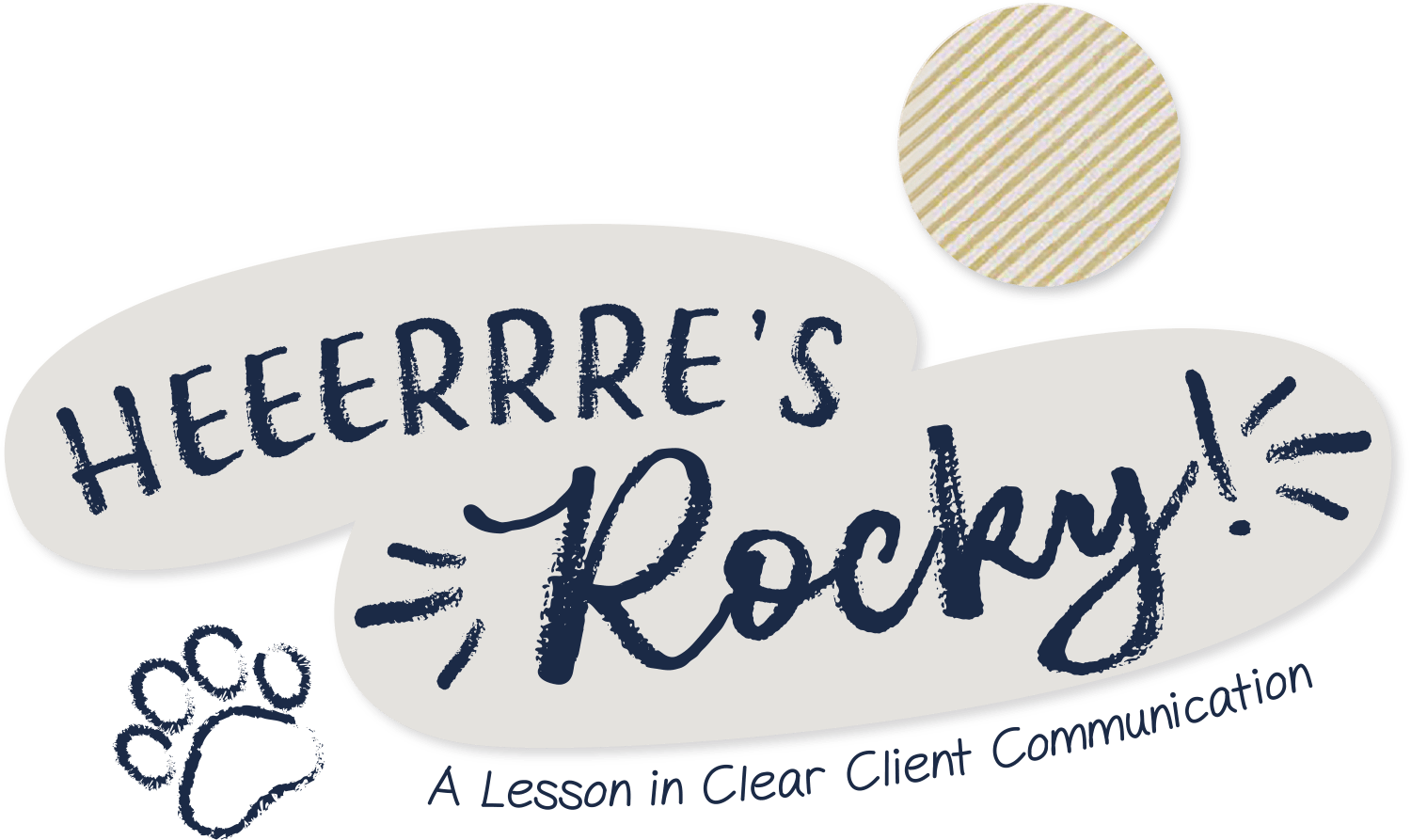

 any years ago, Jill, a first-time client, brought in Rocky, her Old English Sheepdog. He was one year old and had never been groomed. I took one look at him, then said to Jill, “Rocky’s hair is terribly matted. We are going to have to clip it all off.”
any years ago, Jill, a first-time client, brought in Rocky, her Old English Sheepdog. He was one year old and had never been groomed. I took one look at him, then said to Jill, “Rocky’s hair is terribly matted. We are going to have to clip it all off.”
“Oh, no!” she protested, insisting that she brushed her dog regularly and that she liked his hair long and fluffy.
I countered by saying, “That may be, but today he will have to be clipped short all over.”
She wasn’t happy. And as she left, Jill said, “Leave as much hair on him as you can. I don’t want him to be cold.”
All I said in reply was, “I will call you when he is done.”
I started working on Rocky. The poor guy was in such bad shape that the matted pelt of hair came off in pretty much one piece.
When Jill came back to pick him up, I presented the dog to her and said, “Here’s Rocky.”



I replied with, “Right here. This is Rocky.”
“Oh no, that’s not him!” she shrieked emphatically. “My dog is bigger and he has huge muscles! Where’s my Rocky?”
For a moment I was dumbfounded. Then it dawned on me that all along Jill actually thought that the lumpy mats on her dog were his muscles.
“Just a minute,” I said. I had saved the pelt that I removed from Rocky. I pulled it out of the bag and placed it back on the dog. I suddenly felt like Ed McMahon as he introduced Johnny Carson every night on The Tonight Show. I turned around and with a sweep of my arm I said, “Heeerrre’s Rocky!”
Jill gasped, her mouth dropped open and her eyes got as big as saucers as she replied, “That’s really my Rocky? Is all this his hair? How could that have happened??”
I handed the pelt to her. I let her feel the “muscles,” which were about two inches thick, and the outside hair, which she had been brushing, that was still fluffy. Putting the matted pelt back on Rocky spoke volumes to his owner, and now she was able to see that her dog had been wearing a straight jacket of mats.
As a first-time pet owner, Jill burst into tears. Then she sobbed an apology to Rocky for not being “a good dog Mommy,” and promised him she would never let this happen to him again.
I assured her that Rocky would be fine and that is hair would grow back. Then I explained the after-clip care Rocky would need and told Jill that if we put Rocky on a regular grooming schedule, he wouldn’t have to be clipped short again. And I told her I would show her how to brush and comb him at home. From then on, I groomed Rocky every month. And Jill, true to her word, kept him well-brushed and mat-free in between his appointments.
I learned a big lesson that day, too. I realized that I was not clearly communicating with my clients or educating them about what a groomer can and cannot do during the grooming process. I knew as soon as I saw him that Rocky would have to be completely clipped down but I didn’t do a good job of explaining it to the first-time dog owner.
One of the most important components of being a successful groomer is the skill of communicating clearly with your clients. You may think you are already doing a great job of this, but if you look at things from your client’s point of view, you may find ways to improve.
Oftentimes owners don’t give you their full attention when you are talking to them. You have to over-explain things to them—maybe more than once. And some owners, like Jill, truly have no clue that their pet is matted.

Here are a few ways you can educate owners, and protect yourself, if you know a pet will have to be clipped short:
- At check-in, show the owner the matting and explain why it is not possible to “just comb it out.” Hand them a comb and let them try to comb through a mat. Many people won’t believe it until they see and feel it for themselves.
- Explain how time-consuming and potentially risky it is to remove the matting and how skin problems and parasites could be hidden in and under the hair.
- Avoid using the word “shaved;” instead, say that their pet’s matted hair will have to be clipped short, or that he/she will have to have a “smoothie.” Clipped sounds better than shaved or cut, and since you will be using clippers to remove the hair, clipped is the best description of the process.
- Show them before and after photos of several pets that have been completely clipped down.
- Alert the owners to possible issues after the clip such as the pet scratching themselves and creating hot spots or shaking their head and ears until hematomas form.
- Always have the owner sign a matted pet release.
- For your own protection, install cameras to video your grooms.
- Give owners a brochure or handout that explains matting (what causes it, how to prevent it, etc.) to take home that reinforces everything you told them at drop-off and includes their after-grooming care.
- Stress the importance of having their pet groomed regularly to prevent the need for a future complete clip-down.
- Make follow-up care easy for the owner and the pet by setting up the pet’s next appointment at pick-up.
- Put their pet on a recurring schedule of appointments and emphasize how much it benefits their pet.
Taking five to ten minutes to educate the owner before the pet is clipped can save you from a multitude of problems after the groom, and can make all the difference in having an extremely irate client bashing you on social media versus someone who understands and takes responsibility for the condition of their pet.
You’ll find that establishing clear communication with your clients and educating them about all things grooming related can also pay off financially. That once-a-year clip-down can become a monthly regular for the life of the pet. And, the informed owner will sing your praises to all their family and friends and broadcast it all over social media.
I framed the before and after photos of Rocky and also of the pelt I removed from him. For a long time I had them hanging in my salon, and when someone came in with a matted pet, I would tell them his story and then point to the framed collection and say, “Heeerrre’s Rocky!”

 hy is it important for pet groomers to know a little bit about brachycephaly? Well, short-faced dogs are extremely popular as pets, therefore making them frequent customers of groomers everywhere. And because of their physical structures, specific health concerns can be significant during the grooming process.
hy is it important for pet groomers to know a little bit about brachycephaly? Well, short-faced dogs are extremely popular as pets, therefore making them frequent customers of groomers everywhere. And because of their physical structures, specific health concerns can be significant during the grooming process.
Brachycephaly means “short head,” and a variety of purebred dog breeds fit this category. No one list labels them all because the variation of shortness can be significant and is not always agreed upon by all experts. Pugs are a typical example of what is referred to as a “flat-faced” breed, with their super-short muzzles, deep face wrinkles and large, front-facing eyes. On the other end of the spectrum are Cane Corso, which are also considered brachycephalic, although they have a much longer muzzle.
Between the two extremes are a variety of different breeds. Some sites suggest as many as 24 breeds that fall into this category, and there is an assortment of mixed breeds that could be classified as short-headed as well. A quick overview of some of the breeds commonly considered to be brachycephalic include, Boxers, Shih Tzus, Cavalier King Charles, Boston Terriers, French Bulldogs, English Bulldogs, Pekingese, Bullmastiff, Chow Chow, Japanese Chin and, of course, Pugs.
Brachycephalic dogs can be prone to various health concerns, including malformed teeth and jaws, spinal problems and occluded airways. However, what is of most concern to us as pet groomers is their proneness to overheating. One pet insurance provider article I read stated that brachycephalic pets are 2.9 times more likely to have submitted claims for heatstroke than dogs with more typical anatomy. And, if a short-headed pet is overweight, it is more likely to become overheated.
Some dogs in this category also have a condition called brachycephalic obstructive airway syndrome (BOAS). This occurs when the soft tissue of the upper respiratory tract doesn’t have enough room due to the shorted skull.


Even brachycephalic pets that breathe without a struggle under normal conditions need special care while being dried to maintain proper body temperature. Using heated cage dryers on brachycephalic pets can be dangerous. Because their airways are not as efficient at cooling as those of their longer-snouted brethren, short-headed dogs are at a real disadvantage when they are placed into a cage that is soon filled with air that is not only warmer than the surrounding environment, but also has high humidity content from water evaporating off their bodies.
Here are some safe and appropriate drying techniques that should be practiced with short-headed dogs:
- Remove as much moisture from the coat as possible while the dog is in the tub by first using super-absorbent towels, then allowing the dog to shake water off themselves as much as possible and, finally, using thirsty terrycloth towels to remove even more water.
- Use products that help the coat to dry faster.
- Table-dry using low- or no-heat dryers. This ensures that the dog is in an open area with cool air to breathe.
- If you must cage-dry, use dryers without heating elements (they still warm the air a few degrees higher than room temperature because of their motors) or, better yet, use a box fan that will move room-temperature air over the pet.
- Only open cages with wire sides should be used for cage-drying.
- Only cage-dry when the pet is in direct view of a staff member.
- Mount thermometers on each cage so you can tell at a glance if the temperature is safe.
- Provide the pet with a bowl of cool water while it is being cage-dried. (Yes, the water may get spilled, but that is a small thing compared to the dog’s safety.)
- Never use a stand dryer as a cage dryer. Stand dryers are designed to reach far higher temperatures than cage dryers (some go as high as 130 degrees Fahrenheit) and should only be used in open spaces.
- Never cage-dry any animal wearing a muzzle. A muzzled dog cannot pant freely and is more likely to overheat.


Veterinary advice should be sought if any dog is panting excessively, flattening its tongue as it pants, has dark or bright red gums, blue or gray gums, dry or sticky mucous membranes in its mouth, is staggering, is weak, collapses, or shows any signs of respiratory distress. Be sure to keep a rectal thermometer in your first aid kit and know how to use it if you suspect a dog is overheated. The average, normal temperature for dogs is 101-102.5 Fahrenheit.
Brachycephalic dogs, with their enchanting, infantile faces, are irresistible to many people and are wildly popular as pets. Groomers need to be aware of potential health concerns associated with these dogs to keep them safe, comfortable and healthy when we care for them.
- Brachycephalic obstructive airway syndrome: much more than a surgical problem. Vet Q. https://www.ncbi.nlm.nih.gov/pmc/articles/PMC9673814/
- Brachycephalic Research Shows Body Condition Is Key To Thermoregulation. Purina Pro Club. https://www.purinaproclub.com/resources/dog-articles/health/brachycephalic-research-shows-body-condition-is-key-to-thermoregulation
- The Cost Of Cuteness: Health and Welfare Issues Associated with Brachycephalic Dog Breeds. HSVMA. https://www.hsvma.org/brachycephalic
- What Is a Brachycephalic Dog? Southeast Veterinary Neurology. https://sevneurology.com/blog/brachycephalic-dog/

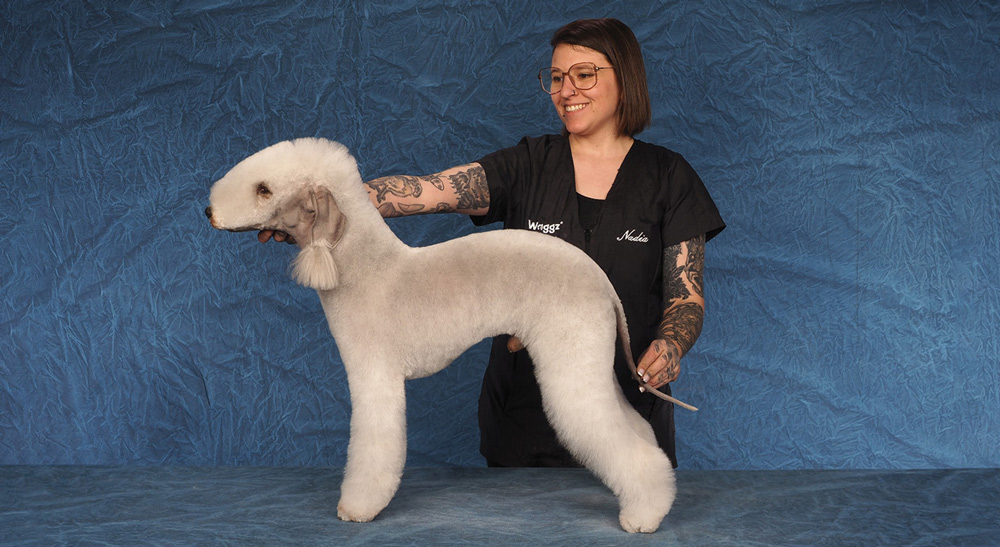
FRIDAY

FRIDAY

FRIDAY

SATURDAY

SATURDAY
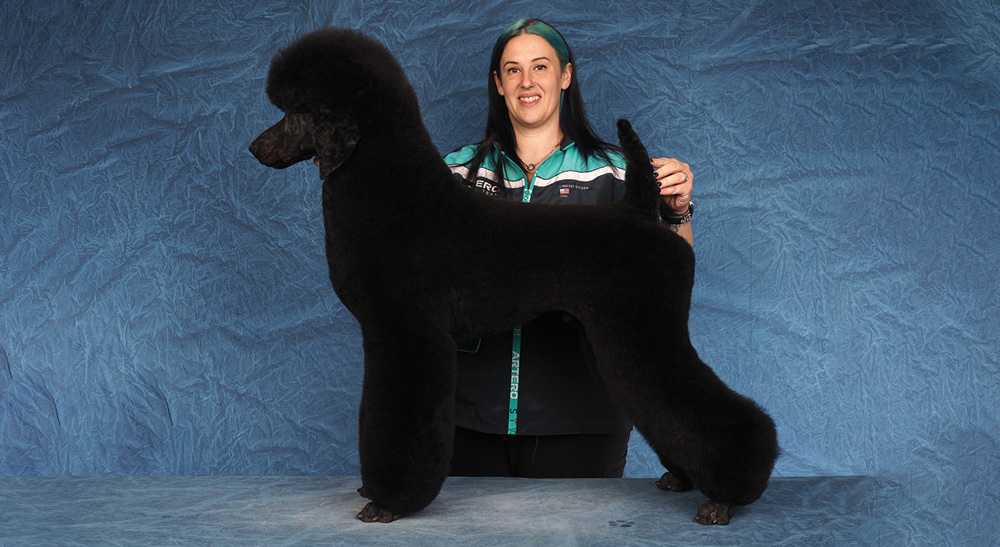
SATURDAY



Best in Show
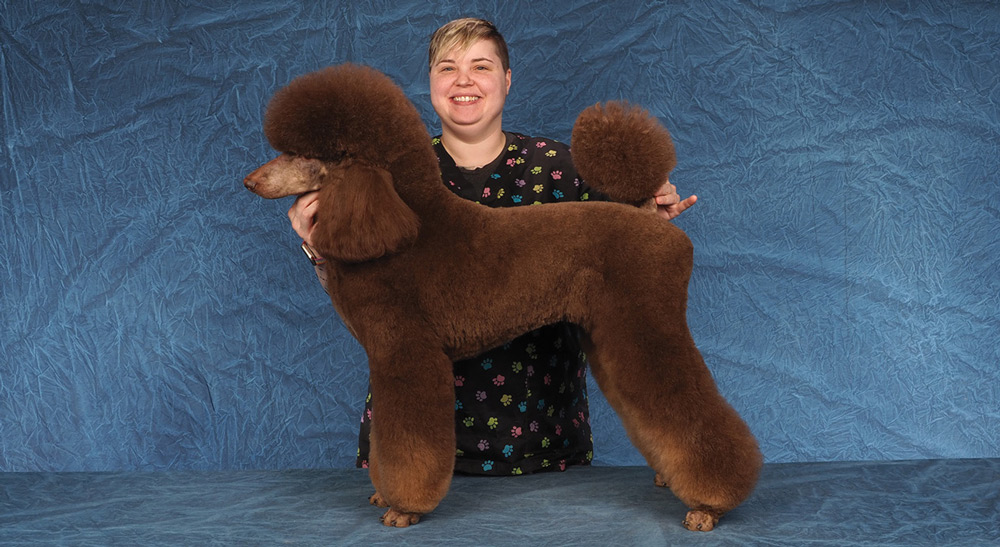
FRIDAY

FRIDAY

FRIDAY
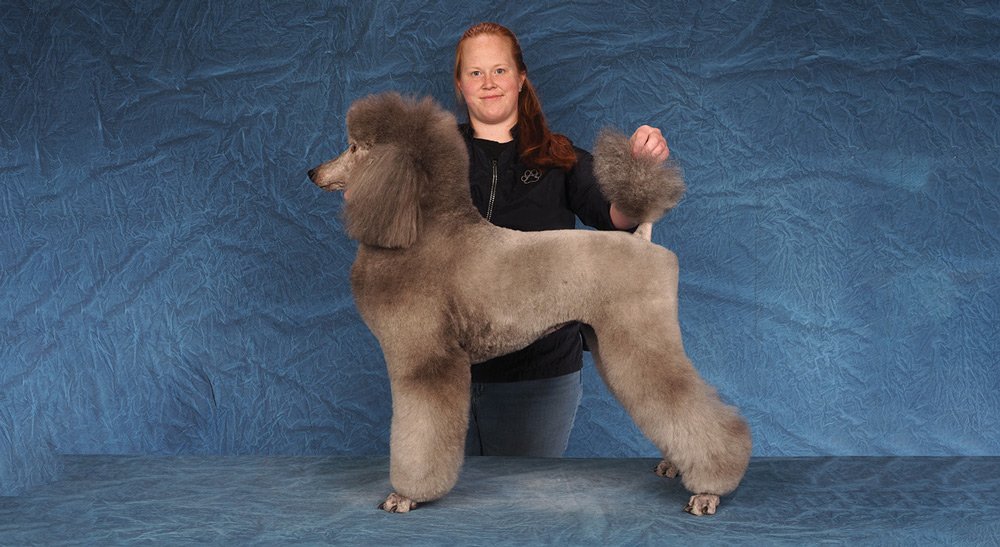
SATURDAY

SATURDAY
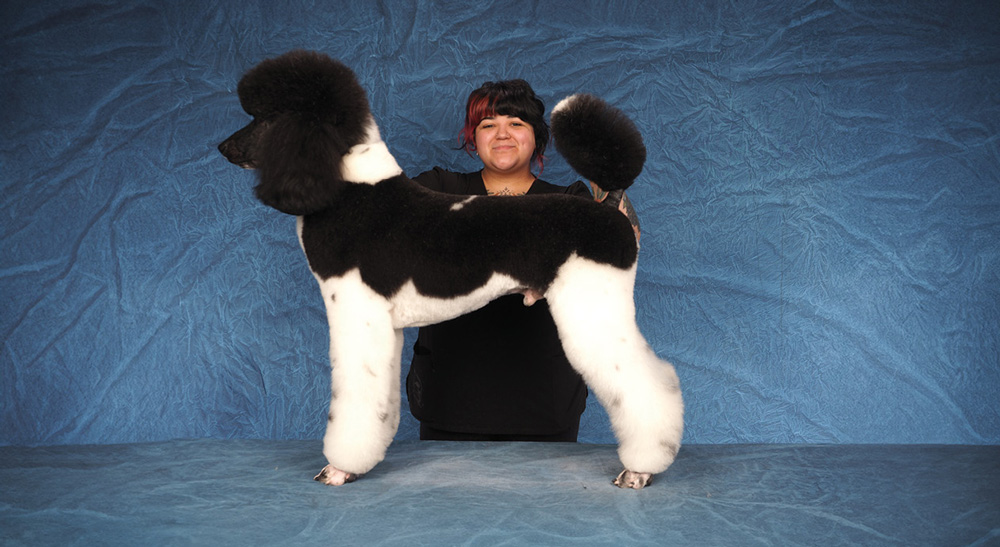
SATURDAY
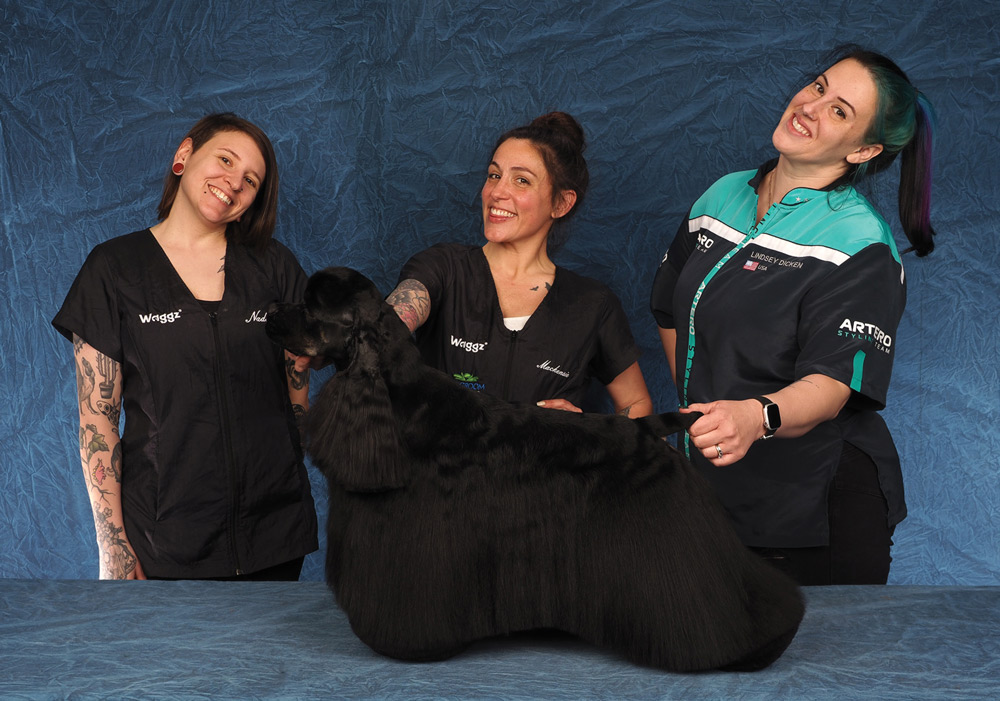
Team Challenge First Place
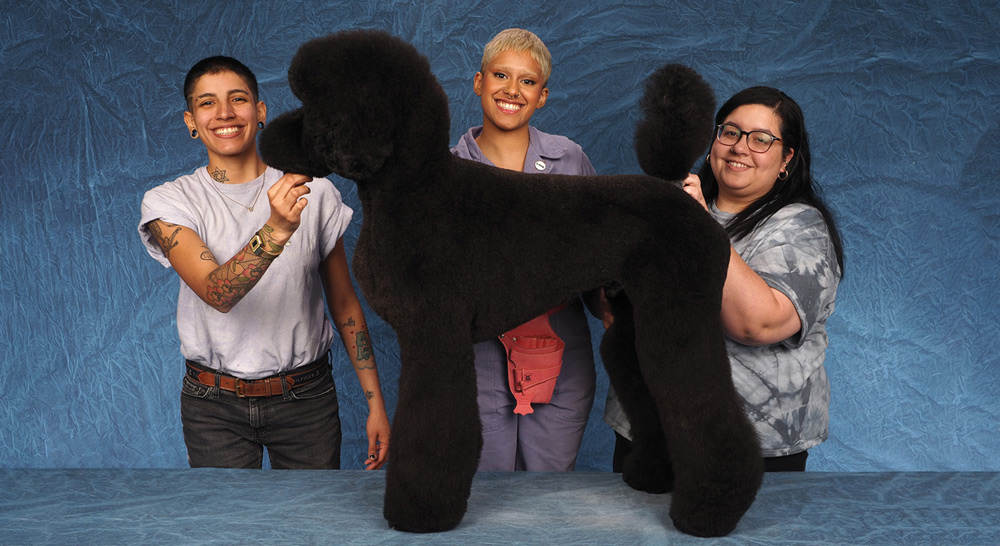
TEAM CHALLENGE SECOND PLACE
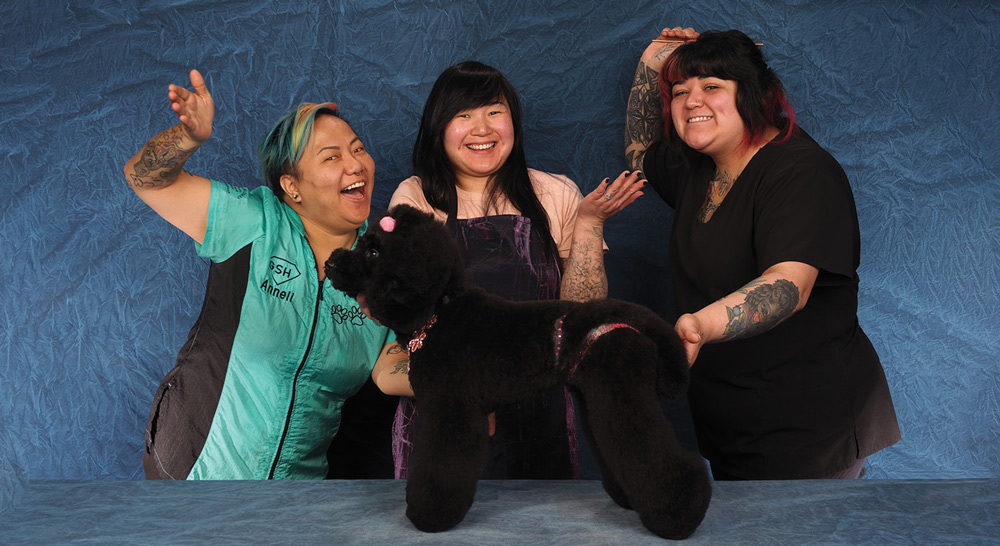
TEAM CHALLENGE THIRD PLACE
Creative Runway

CREATIVE RUNWAY First Place

CREATIVE RUNWAY SECOND PLACE

CREATIVE RUNWAY THIRD PLACE

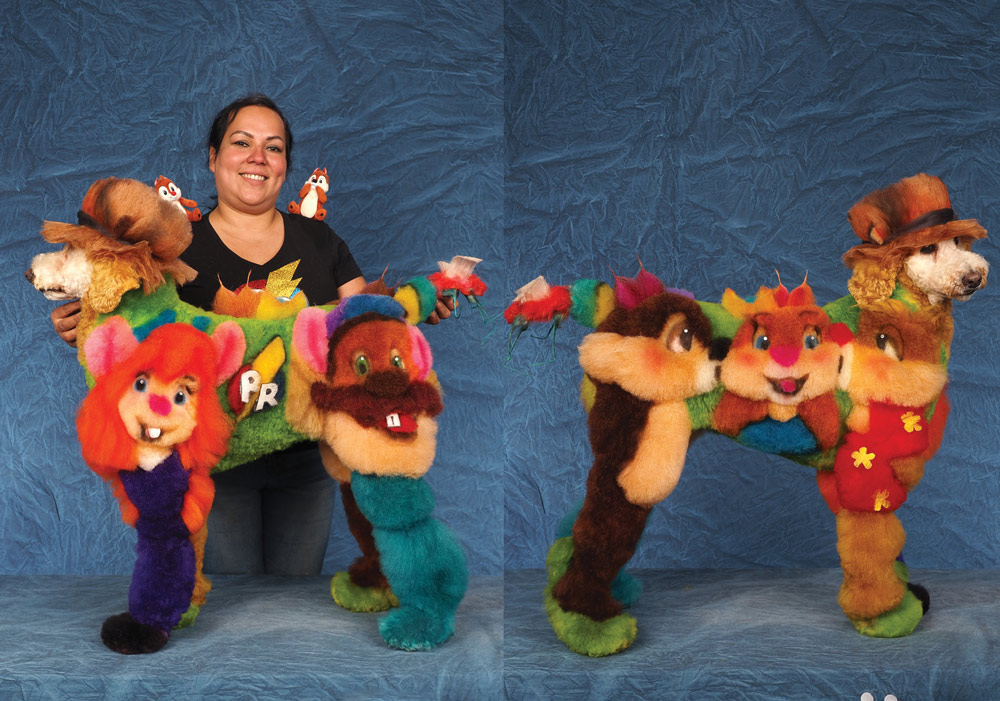
PEOPLE'S CHOICE
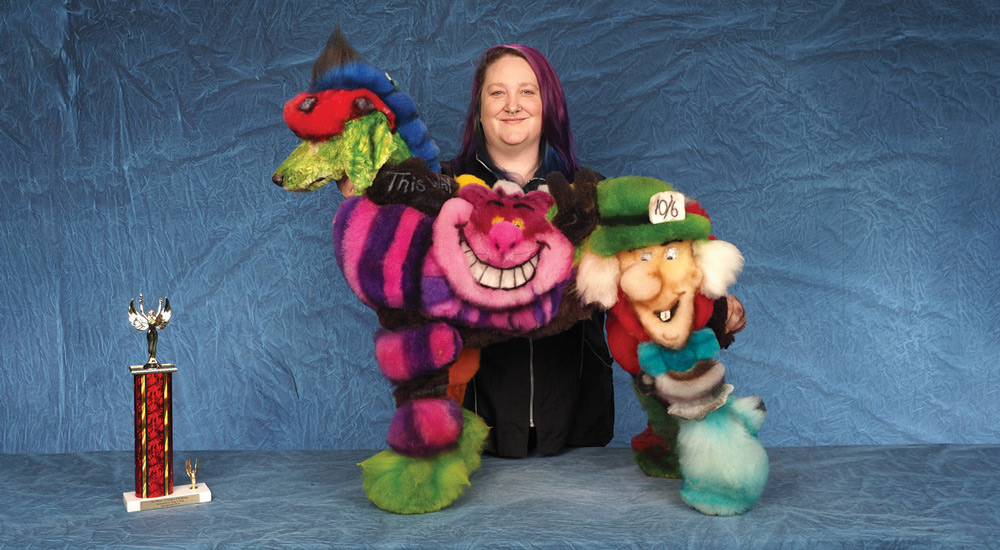

CREATIVE STYLING FIRST PLACE


CREATIVE STYLING SECOND PLACE

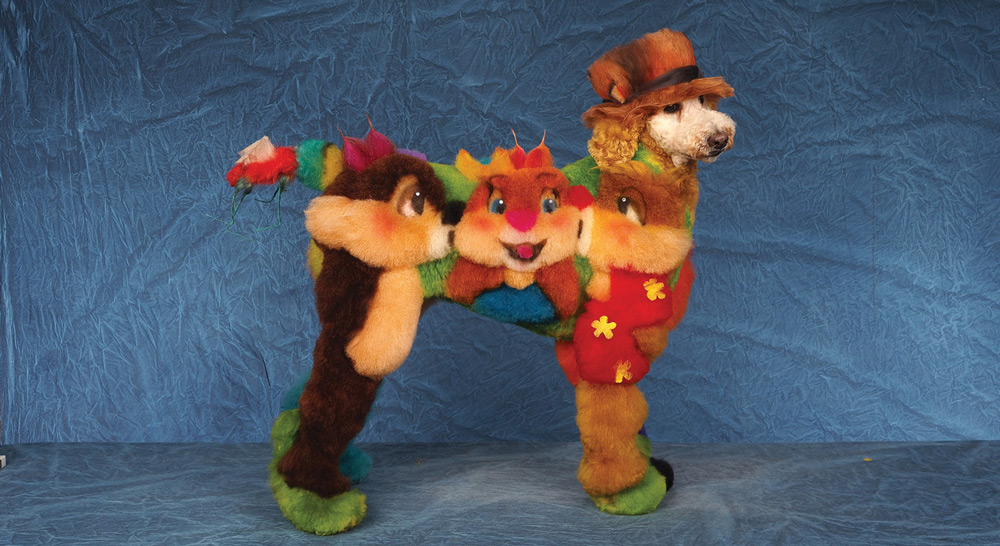
CREATIVE STYLING THIRD PLACE

BEST FIRST TIMER

BEST FIRST TIMER

by Lynn Paolillo
 raditionally overshadowed by dog grooming services, the demand for cat-specific grooming is becoming a more prominent part of the pet care industry. This increase is driven by a greater understanding of cat behavior, the rise in cat ownership, and the recognition that cats—much like their canine counterparts—benefit from regular grooming for their health and wellbeing.
raditionally overshadowed by dog grooming services, the demand for cat-specific grooming is becoming a more prominent part of the pet care industry. This increase is driven by a greater understanding of cat behavior, the rise in cat ownership, and the recognition that cats—much like their canine counterparts—benefit from regular grooming for their health and wellbeing.
Certified Feline Master Groomers and dedicated cat grooming studios are emerging at a rapid rate, signaling a growing side of the industry that caters specifically to feline needs. For groomers contemplating a cat-exclusive path, understanding the nuances of this specialized sector can offer insights into its viability, challenges and rewards.
Owners are more likely to engage with and recommend businesses where they feel their feline family members are not just accommodated but 

Education and Certification
As the pet care industry continues to evolve, the demand for specialized services, including cat-exclusive grooming, is on the rise. By creating an environment that caters specifically to the needs of felines and their owners, groomers can tap into a niche market that offers not just financial rewards, but also the satisfaction of providing a much-needed service.
With the right preparation, understanding and commitment, going cat exclusive can be a rewarding endeavor for those passionate about the wellbeing of our feline friends.


by Dominic Hodgson
 icture this: Sarah, an experienced and passionate groomer, has, on the surface, a thriving pet grooming salon. Her clients rave about her impeccable grooming skills and the genuine care she provides to their furry companions. However, behind the scenes, Sarah faced a common challenge that many groomers can relate to—the uncertainty of income and the constant struggle to fill her appointment book.
icture this: Sarah, an experienced and passionate groomer, has, on the surface, a thriving pet grooming salon. Her clients rave about her impeccable grooming skills and the genuine care she provides to their furry companions. However, behind the scenes, Sarah faced a common challenge that many groomers can relate to—the uncertainty of income and the constant struggle to fill her appointment book.
Despite her top-notch grooming talents, Sarah found herself at the mercy of unpredictable no-shows, last-minute cancellations and clients who were hesitant to invest in additional services. She worked incredibly hard to implement a fresh, high-standard grooming experience for the dogs in her care, but still her bank balance didn’t improve. Sarah knew there had to be a better way to ensure a stable income and build lasting client relationships.
So, what was the missing ingredient?
Sarah had forgotten that it’s the client who pays the bills, and she needed a better way to turn her top-notch grooming skills into a reliable and profitable service.
The Systems That Power Your Business
selling is actually a process—a series of selling steps, a bit like a well-choreographed dance routine, where each step contributes to the overall performance.
Most people think of sales as a one-time activity where the customer either buys or they don’t. However, selling is more sophisticated than that, because selling is actually a process—a series of selling steps, a bit like a well-choreographed dance routine, where each step contributes to the overall performance. Imagine how successful your salon would be if your selling system was as reliable as your service delivery system.
Three Essential Groomer Sales Systems

The “Only Good Clients” System
You might get one or two potential clients who don’t like the idea of pre-paying, but these will usually be the same people who cancel last minute, moan about your prices and are generally a nightmare to deal with (and you can live without them).

The “Easy-Peasy Upsell” System
They may need some guidance to get them started, so help them by asking what they find frustrating or worrying about their dog’s appearance. Then, when they tell you they love their pooch more than life itself but worry about their shedding, matted coat and dry nose, you’re set up perfectly to offer them de-shedding, de-matting and facial upsells.
I’d also recommend you make a note of these pet peeves on your client forms, because that information will come in very handy next time you have a new service or a product you want to promote.
To make the sales process easier, you should have a printed-out menu of the upsell options on hand to help you sell these extra services. Think of it like a specials board or a dessert menu in a restaurant; seeing pictures and descriptions of your upsell options will help clients to understand the benefits.
Remember, it’s easier to sell more services to existing clients than it is to find new clients, so be prepared to put some thought and effort into the marketing materials you create to promote your upsells.

The “Customer Cloning” System
To increase the number of people who take part, I would also send them home with a postcard outlining the review instructions and send a reminder email the day after the groom. Remember, the fortune is in the follow up! In addition, you can add some urgency to this request by theming the free treatment as a seasonal special and do it over Christmas, Valentine’s Day or Easter.
So, there you go. Three simple sales systems that will increase profits and spread the word about your business.
Now, you may be thinking, I kind of do that already. But, do you really?
Do you have set-in-stone systems that ensure this sales process happens with every client who walks through the door? Have you trained staff members so they know the sales process steps as well as they know the grooming process? Have you documented the process and created sales scripts, presentation aids and a checklist so no opportunity is missed?
If not, you could be leaving a lot of money on the table.
Sarah transformed the profitability of her salon when she got serious about systemizing her sales process, and you can too. So what are you waiting for?
Dom Hodgson is known as the Pet Biz Wiz. His mission is to help pet service providers create superior customer service systems that enable them to build an impactful and profitable pet business. Dom has written over nine books including “How to Disnify Your Pet Business” which you can purchase at www.petbusinessmarketing.com/magicbook.
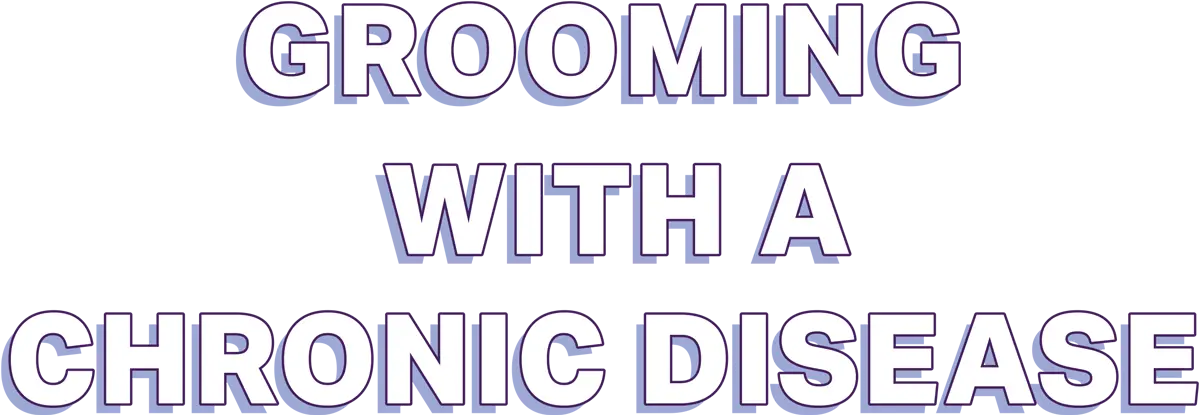
 any groomers struggle with the effects of chronic diseases every day. From arthritis to diabetes, chronic diseases come in many forms. What do you do when you are diagnosed with a chronic disease? Is it possible to continue to groom? What steps should you take to adjust to the often life-changing effects?
any groomers struggle with the effects of chronic diseases every day. From arthritis to diabetes, chronic diseases come in many forms. What do you do when you are diagnosed with a chronic disease? Is it possible to continue to groom? What steps should you take to adjust to the often life-changing effects?
It may feel daunting, overwhelming or even depressing. You may feel hopeless or like your world is crashing down around you when you are first diagnosed. I was 14 years old when I was diagnosed with Chronic Fatigue Syndrome, Arthritis and Fibromyalgia. Then in my early 20s, I was diagnosed with Degenerative Disc Disease and other ailments that really took the breath out of me. Each time I was diagnosed with a new disease, I felt robbed and frustrated. I had to lean on my faith and family, and go through the process of grieving.
Everyone will have to grieve at some point in their life—whether from a death of a loved one or a horrible medical diagnoses. Grief is a healthy way to cope with the stresses of life-altering events. However, once you have gone through the grieving stages, you have to come to grips with the fact that some things will change in your life. Your profession is a major factor where you may need to make adjustments for your own health’s sake. Can you still work with most chronic diseases? Absolutely. Will it look different? Absolutely.
It is vital to realize that although you have been diagnosed with a chronic disease, you are likely still capable of working; however, you may not be able to do everything you have done before in the same way. You will come to realize that every single person’s journey is different. To compare is to despair. Focus on you and what you are capable of doing.
For example, if you have back problems, spend the extra money for a table that raises and lowers so you don’t have to bend to reach the dogs. Make sure you have a ramp or stairs into the tub so you no longer need to lift dogs. Close the gap between you and the tub so you won’t need to bend over the dogs. Organize your supplies so they are within arm’s length and you don’t need to stretch to reach for things while you’re grooming.
Review your client list. If this chronic disease is going to affect you for the rest of your life, why allow “problem clients” to be a part of it? If you realize you need to cut back on clients, don’t feel guilty weeding out the difficult clients and/or dogs. This will help give you the energy you need to focus on the dogs you choose to groom.

 long-time popular pet breed, Maltese are known for their adorable large eyes and striking white coats, but groomers know how challenging it is to trim up such a soft-textured drop coat. The following will outline an easy-to-execute, go-to style used to revamp a pet dog’s last “home haircut.”
long-time popular pet breed, Maltese are known for their adorable large eyes and striking white coats, but groomers know how challenging it is to trim up such a soft-textured drop coat. The following will outline an easy-to-execute, go-to style used to revamp a pet dog’s last “home haircut.”Fig 1) Every good trim starts with a nice bath and fluff. Scrub the skin and blow the coat straight so you can really see what you’re working with. This is especially important for when you are changing a dog’s style.
Fig 2) I often use a half-inch guard comb on pet dogs in general, but on a white dog with pink skin, a half-inch is about as short as you can go without exposing their delicate skin. Use your selected length to clip the body of the dog.


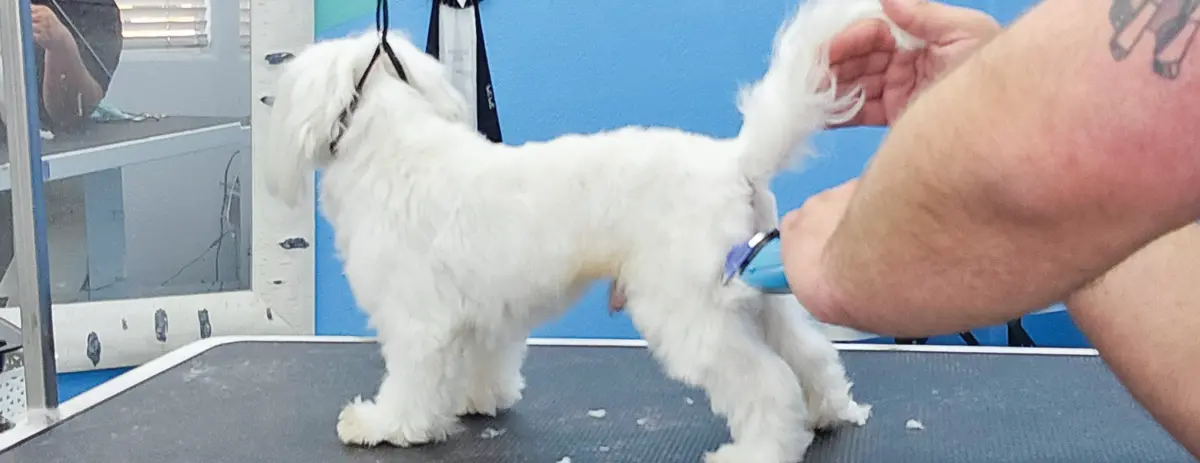

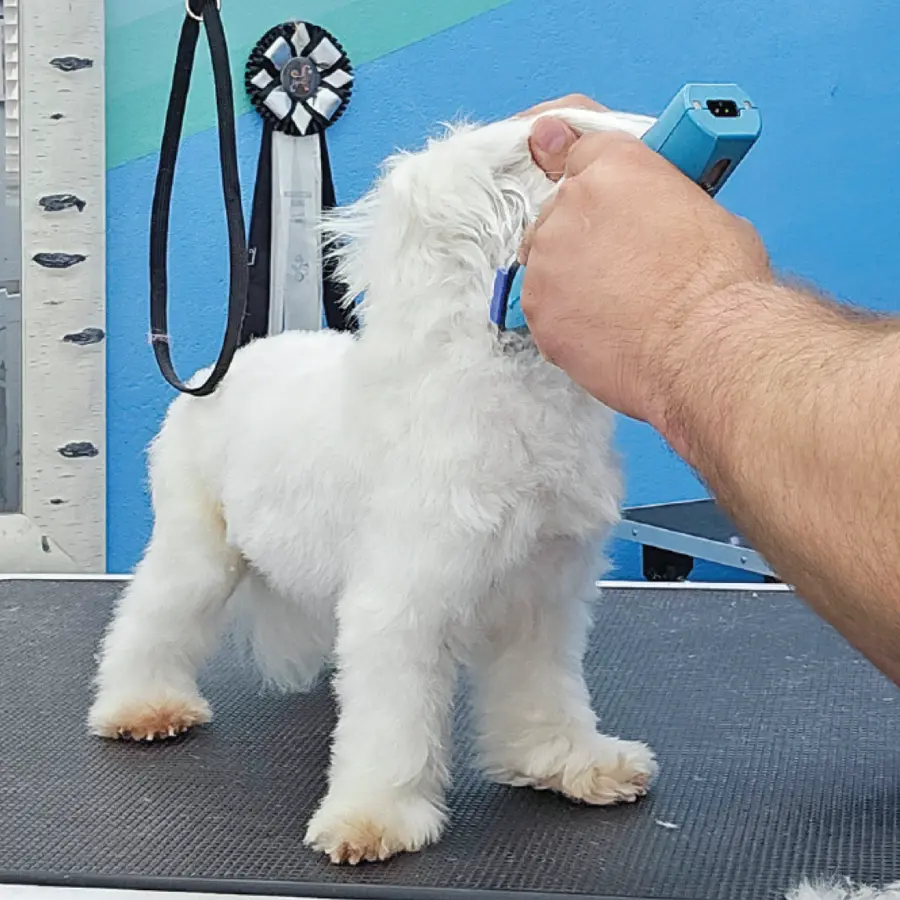
Fig 4) For a pet style, I always trim the feet tight and all the way up to the pad so their groom lasts longer.




Fig 4) For a pet style, I always trim the feet tight and all the way up to the pad so their groom lasts longer.



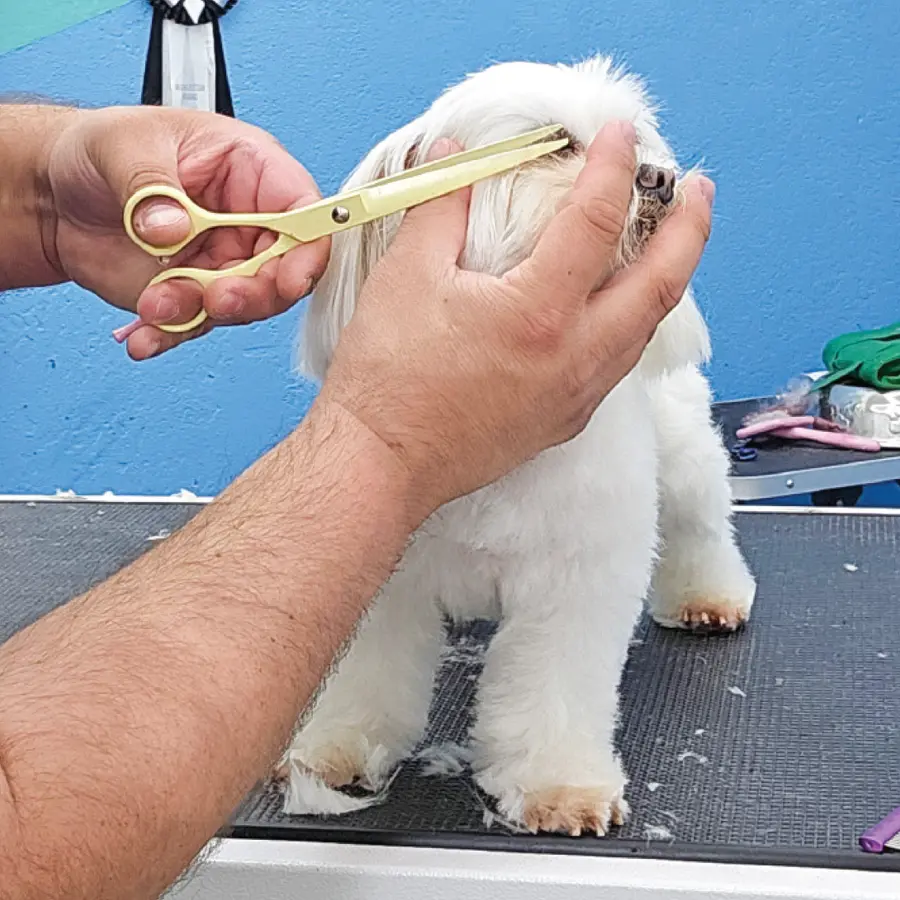



Fig 6) From the back of the occiput and down to the body, go one length longer so that you can transition the topknot into the shoulders more easily.








by Anjie Coates
Photo by Anjie Coates

 jax is a Furloughed Favorite lab from the New England Assistance Dog Services who comes in regularly with his sister, Stirling. He’s normally pretty lazy and likes his naps, but this day he was a little slower than usual.
jax is a Furloughed Favorite lab from the New England Assistance Dog Services who comes in regularly with his sister, Stirling. He’s normally pretty lazy and likes his naps, but this day he was a little slower than usual.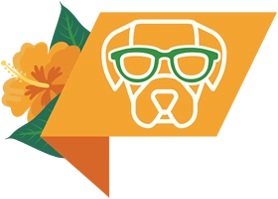 Ajax: “Hi Anj! I’ll be in bed,” as he walks down the hall to the crate he usually uses, goes in and lies down.
Ajax: “Hi Anj! I’ll be in bed,” as he walks down the hall to the crate he usually uses, goes in and lies down. “You’re going in the tub in two minutes, buddy,” I tell him.
“You’re going in the tub in two minutes, buddy,” I tell him. Ajax: “Take Stirling first.
Ajax: “Take Stirling first.
I’m napping.” A moment later, he’s sleeping comfortably, so his sister gets bathed first.
A moment later, he’s sleeping comfortably, so his sister gets bathed first. “Hey, buddy, time to wake up,” I say as I give his head a rub to wake him.
“Hey, buddy, time to wake up,” I say as I give his head a rub to wake him. Ajax: “Huh? I’ll go after Stirling.”
Ajax: “Huh? I’ll go after Stirling.” “You are going after Stirling; she’s done. The tub is ready. Come on,” I tell him.
“You are going after Stirling; she’s done. The tub is ready. Come on,” I tell him. Ajax slowly gets up, stretches, shakes, and then dutifully heads to the tub, walks up the ramp and stretches one more time: “Ready!”
Ajax slowly gets up, stretches, shakes, and then dutifully heads to the tub, walks up the ramp and stretches one more time: “Ready!” His bath goes as always, with happy grunts and tap-dancing back feet when his back end gets washed.
His bath goes as always, with happy grunts and tap-dancing back feet when his back end gets washed.
 “OK. Toweling, oils, and then the table,” I list.
“OK. Toweling, oils, and then the table,” I list. Ajax: “And rubs!”
Ajax: “And rubs!” “Yes, and rubs,” I assure him.
“Yes, and rubs,” I assure him. After applying his coat oils and massaging them in, I take him back to this crate so I can clean the tub for the next dog.
After applying his coat oils and massaging them in, I take him back to this crate so I can clean the tub for the next dog. “Off to bed for a few minutes and then we’ll finish you,” I say.
“Off to bed for a few minutes and then we’ll finish you,” I say. Ajax: “Don’t forget my towel.”
Ajax: “Don’t forget my towel.” “I would never,” I quip as I grab his heated towel and lead him down the hallway.
“I would never,” I quip as I grab his heated towel and lead him down the hallway. I crawl into the crate and make sure the towel is completely spread out, but am unable to get out because Ajax is blocking the doorway.
I crawl into the crate and make sure the towel is completely spread out, but am unable to get out because Ajax is blocking the doorway. “Umm, buddy? We both don’t fit in the door here; you need to back up,” I tell him.
“Umm, buddy? We both don’t fit in the door here; you need to back up,” I tell him. Ajax: “I was checking to make sure it was all nice.”
Ajax: “I was checking to make sure it was all nice.”-

 “It is, but you need to slide over,” I say.
“It is, but you need to slide over,” I say. Instead, Ajax shoulders his way past me, turns around in the crate, gives me a kiss, plops down and begins rubbing all over the towel, kicking his feet in the air.
Instead, Ajax shoulders his way past me, turns around in the crate, gives me a kiss, plops down and begins rubbing all over the towel, kicking his feet in the air.
 “I’m so glad I made it all nice,” I quip.
“I’m so glad I made it all nice,” I quip. Ajax: “Me too. Thanks, Anj,” as he settles in to the mostly balled-up towel and falls asleep.
Ajax: “Me too. Thanks, Anj,” as he settles in to the mostly balled-up towel and falls asleep. After the tub is clean, I return to wake him again.
After the tub is clean, I return to wake him again. “C’mon, I have to finish you,” I say.
“C’mon, I have to finish you,” I say. Ajax: “Sleeping. Come back later.”
Ajax: “Sleeping. Come back later.” “I’ll give you a treat,” I taunt.
“I’ll give you a treat,” I taunt. Ajax pops up like he was shot out of a cannon and runs to my table.
Ajax pops up like he was shot out of a cannon and runs to my table. I give him a treat and help him onto the table, which he’s never needed help with before, so I ask, “You’re awfully tired today. How come?”
I give him a treat and help him onto the table, which he’s never needed help with before, so I ask, “You’re awfully tired today. How come?” Ajax: “Just sleepy.”
Ajax: “Just sleepy.” “Well, you’re normally sleepy, but not quite this sleepy,” I say with concern.
“Well, you’re normally sleepy, but not quite this sleepy,” I say with concern. Ajax wags as I dry him and then begin to do his nails.
Ajax wags as I dry him and then begin to do his nails. “You are the best boy. You know that, right?” I ask.
“You are the best boy. You know that, right?” I ask. Ajax: “I heard you say that to that other dog.”
Ajax: “I heard you say that to that other dog.”
 “Uhh…well, you’re the best boy on nails,” I manage.
“Uhh…well, you’re the best boy on nails,” I manage. “Hey, how come your nails are suddenly all flakey and brittle?” I ask.
“Hey, how come your nails are suddenly all flakey and brittle?” I ask. Ajax: “You always say it’s like cutting rebar.”
Ajax: “You always say it’s like cutting rebar.” “Yeah, because normally they are. Today, though, they aren’t. I have to tell your mom about this,” I say.
“Yeah, because normally they are. Today, though, they aren’t. I have to tell your mom about this,” I say. Ajax: “You said I was good!”
Ajax: “You said I was good!” “You’re the best, buddy, but something is happening here between you being so sleepy and your nails being so different. Your mom needs to know something is going on,” I say.
“You’re the best, buddy, but something is happening here between you being so sleepy and your nails being so different. Your mom needs to know something is going on,” I say. Ajax: “As long as I’m still the best boy.”
Ajax: “As long as I’m still the best boy.” “You are! You’re also by far the cutest black lab boy I groom,” I tell him as I kiss his nose, but don’t mention he’s the only black lab boy I groom.
“You are! You’re also by far the cutest black lab boy I groom,” I tell him as I kiss his nose, but don’t mention he’s the only black lab boy I groom. Ajax: “The cutest boys get more treats, right?” as he returns the kiss and grins.
Ajax: “The cutest boys get more treats, right?” as he returns the kiss and grins. And I reply,
And I reply,

I did let his mom know what was going on and she took him to the vet that very day. It turns out Ajax had a porcupine quill that migrated and caused an infection, making him sleepy and his nails brittle. After a round of antibiotics and a quill removal, he was as good as new.

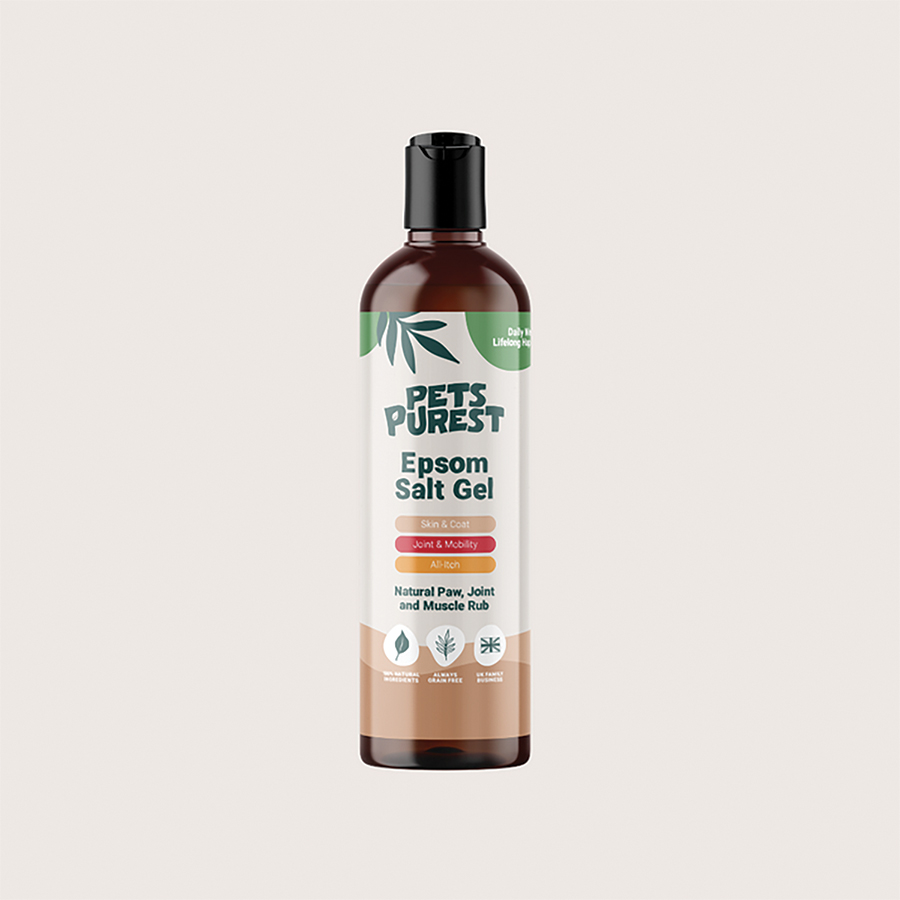
Pets Purest Natural Epsom Salt Gel is an ideal paw, joint, and muscle rub, promoting muscle recovery and supporting the body’s natural anti-inflammatory response. Its skin-soothing properties are also perfect for sensitive and/or irritated paws. Enriched with wintergreen, lavender and aloe vera, this 100%-natural formula contains no harsh chemicals or fragrances, making it ideal for all pets over 12 weeks old, even the most sensitive ones. Simple apply it directly onto the affected area as required, ensure the gel is fully absorbed and allow to dry. Do not use on open wounds. www.petspurest.com

CLASSIFIEDS
![]() Loyal customer base
Loyal customer base
![]() New clientele every week
New clientele every week
![]() Fully equipped grooming stations
Fully equipped grooming stations
![]() Prime location in Chicagoland area
Prime location in Chicagoland area
![]() Desirable location in upper-middle-class neighborhood
Desirable location in upper-middle-class neighborhood
![]() Has capacity to accomodate additional groomers; spacious, bright, clean, and open shop
Has capacity to accomodate additional groomers; spacious, bright, clean, and open shop
![]() Designated, private, cat grooming area
Designated, private, cat grooming area
![]() Laundry
Laundry
![]() Office
Office
![]() Hassle-free parking
Hassle-free parking
Call broker Larry at 630.796.0070, EXT: 1, for more details. Email: lswanson@tworld.com
Call (717) 691-3388 ext 224 to place a Classified.
Rates: 25 words or less
$50.00
$2.00 each.
Classified ads must be prepaid.
Call for issue deadlines.
Agency discounts do not apply.


